First Computer DN95W3BB Notebook Computer With 802.11/b WLAN Module User Manual 1 of 2
First International Computer Inc Notebook Computer With 802.11/b WLAN Module 1 of 2
Contents
- 1. User Manual 1 of 2
- 2. User Manual 2 of 2
User Manual 1 of 2

Notebook User Guide
1
Copyright©2003
All Rights Reserved - Printed in Taiwan
Notebook Computer User Guide
Original Issue: 2003/3
This manual guides you in setting up and using your new notebook computer.
Information in this manual has been carefully checked for accuracy and is subject
to change without notice.
No part of this manual may be reproduced, stored in a retrieval system, or
transmitted, in any form or by any means, electronic, mechanical, photocopy,
recording, or otherwise, without prior written permission.
Trademarks
Product names used herein are for identification purposes only and may be the
trademarks of their respective companies.
Microsoft, MS-DOS, Windows, and Windows Sound System are trademarks of
Microsoft Corporation.
Intel and Intel Pentium / Pentium 4 are a registered trademark of Intel
Corporation.
Sound Blaster, Sound Blaster Pro are trademarks of Creative Technology.
All other brands or product names mentioned in this manual are trademarks or
registered trademarks of their respective companies.

Notebook User Guide
2
FCC Information to User
Safety and Care Instructions
No matter what your level of experience with computers, please make sure you
read the safety and care instructions. This information can help protect you and
your computer from possible harm.
Radio and television interference
Warning: Use the specified shielded power cord and shielded signal cables with
this computer, so as not to interfere with radio and television reception. If you
use other cables, it may cause interference with radio and television reception.
This equipment has been tested and found to comply with the limits for a Class
B digital device, pursuant to Part 15 of the FCC Rules. These limits are designed
to provide reasonable protection against harmful interference in a residential
installation. This equipment generates, uses and can radiate radio frequency energy
and, if not installed and used in accordance with the instructions, may cause
harmful interference to radio communications. However, there is no guarantee
that interference will not occur in a particular installation. If this equipment does
not cause harmful interference to radio or television reception, which can be
determined by turning the equipment off and on, the user is encourage to try to
correct the interference by one or more of the following measures:
• Reorient or relocate the receiving antenna
• Increase the separation between the device and receiver
• Connect the device into an outlet on a circuit different from that to which the
receiver is connected.
• Consult the dealer or an experienced radio/television technician for help.
You may find helpful the following booklet, prepared by the Federal
Communications Commission: Interference Handbook (stock number 004-000-

Notebook User Guide
3
00345-4). This booklet is available from the U.S. Government Printing Office,
Washington, DC20402
Warning: The user must not modify or change this computer without approval.
Modification could void authority to this equipment.
FCC RF Radiation Exposure Statement:
This Transmitter must not be co-located or operating in conjunction with any
other antenna or transmitter.
This equipment complies with FCC RF radiation exposure limits set forth for an
uncontrolled environment. This equipment should be installed and operated
with a minimum distance of 20 centimeters between the radiator and your body.
15.247 (b)(4), the EUT meets the requirement that it be operated in a manner
that ensures the public is not exposed to radio frequency energy levels in excess of
the Commission’ s guidelines (1.1307, 1.1310, 2.1091 and 2.1093)
Canadian Department of Communications Compliance
Statement
This Class B digital apparatus meets all requirement of the Canadian Interference-
Causing Equipment Regulations.
Shielded Cables Notice
All connections to other computing devices must be made using shielded cables
to maintain compliance with FCC regulations.
Peripheral Devices Notice
Only peripherals (input/output devices, terminals, printers, etc) certified to
comply with Class B limits may be attached to this equipment. Operation with

Notebook User Guide
4
non-certified peripherals is likely to result in interference to radio and TV
reception.
CD-ROM Notice
The CD-ROM and Combo drive are Class One Laser Product.
Caution
Changes or modifications not expressly approved by the manufacturer may void
the user’ s authority, which is granted by the Federal Communications
Commission, to operate this computer.
Use Conditions
This part complies with Part 15 of the FCC Rules. Operation is subject to the
following conditions: (1) this device may not cause harmful interference, and (2)
this device must accept any interference received, including interference that may
cause undesired operation.
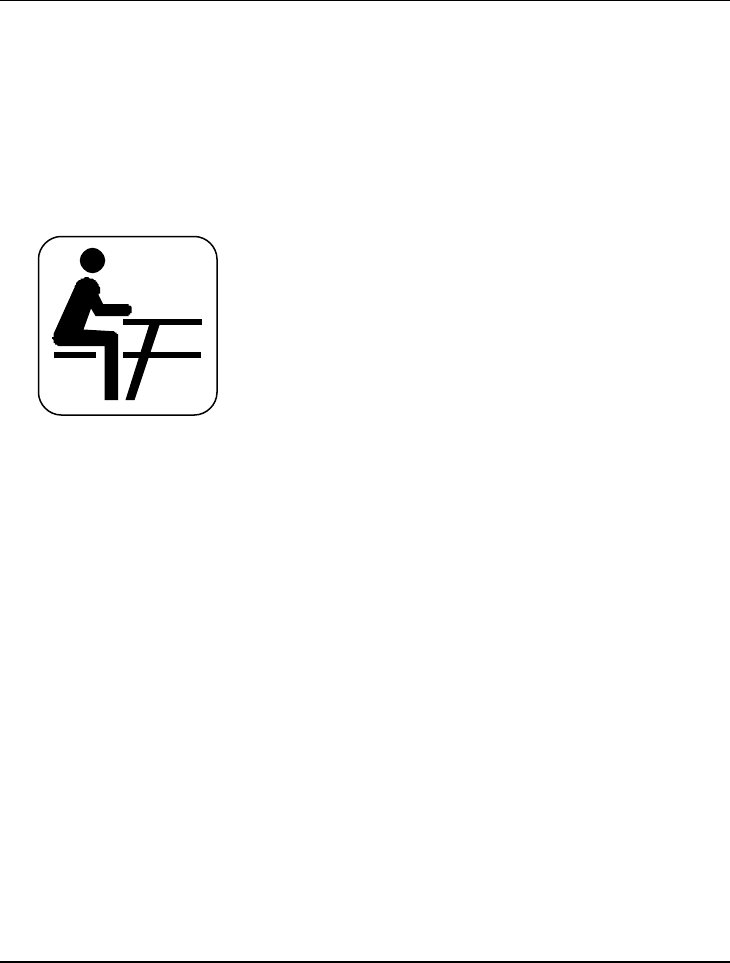
Notebook User Guide
5
About Your Notebook Computer
Congratulation for having purchased your new Professional
Multimedia Notebook. This notebook incorporates the
strongest features, which integrate the latest technologies
available in the notebook industry.
Your new notebook computer not only drives today̆
multimedia applications but also be ready for tomorrow̆
exciting new software.
This Professional Multimedia Notebook is a freedom, flexibility,
and functionality notebook that users are demanding for a long
time.
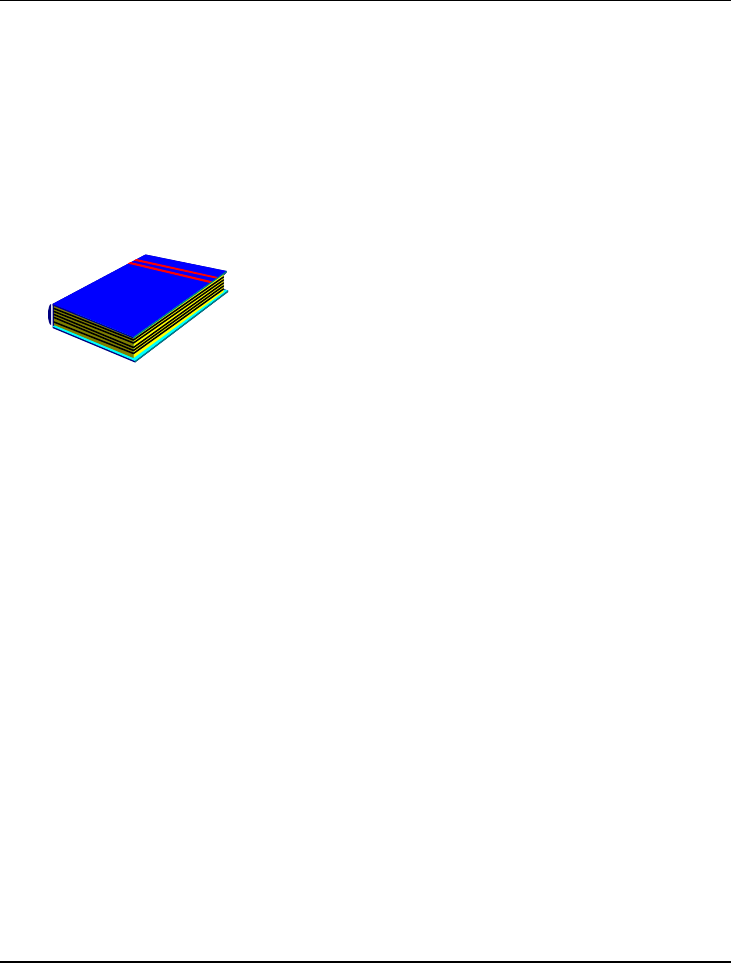
Notebook User Guide
6
About Your User Guide
Welcome to your Professional Multimedia Notebook User
Guide. This manual covers everything you need to know in
learning how to use your computer. This manual also assumes
that you know the basic concepts of Windows and the PC. You
will start doing a lot of great and fun things with your
computer.
This manual is divided into seven chapters.
Chapter 1 gives introduction on your computer features.
Chapter 2 provides step-by-step instructions to help you
begin using your notebook as quickly as possible.
Chapter 3 describes how to operate the standard features of
your computer.
Chapter 4 illustrates how to integrate video and sound
chips into impressive presentation.
Chapter 5 illustrates how to connect external device to your
computer.
Chapter 6 explains how to use the System BIOS Setup
program.
Chapter 7 explains how to use the internal module options
of your computer.
Chapter 8 offers instructions on how to care and maintain
your notebook.

Notebook User Guide
7
Table of Contents
ABOUT YOUR NOTEBOOK COMPUTER ................................................................................. 5
ABOUT YOUR USER GUIDE......................................................................................................... 6
1 INTRODUCTION ..................................................................................................................13
1.1 FEATURE HIGHLIGHT ...........................................................................................14
1.2 UNPACKING THE COMPUTER .............................................................................16
1.3 THE INSIDE OF THE NOTEBOOK.........................................................................17
Power/Wireless LAN/Mail Status Icons.............................................................................19
Status LED Icons....................................................................................................................20
The Function of CPU Speed Adjustment Buttons............................................................22
1.4 THE FRONT SIDE OF THE NOTEBOOK...............................................................23
1.5 THE REAR SIDE OF THE NOTEBOOK .................................................................23
1.6 THE LEFT SIDE OF THE NOTEBOOK ..................................................................25
1.7 THE RIGHT SIDE OF THE NOTEBOOK................................................................27
1.8 THE UNDERSIDE OF THE NOTEBOOK................................................................28
1.9 NOTEBOOK ACCESSORIES....................................................................................29
1.10 NOTEBOOK OPTIONS............................................................................................30
2 GETTING STARTED ............................................................................................................33
2.1 INSTALLING THE HARD DISK ..............................................................................34
2.2 USING THE BATTERY PACK ................................................................................35
Extending Battery Life ..........................................................................................................38
2.3 CONNECTING THE AC POWER SOURCE ............................................................39
2.4 STARTING YOUR COMPUTER..............................................................................40
2.5 ADJUSTING THE DISPLAY CONTROLS...............................................................41
2.6 INSTALLING THE NOTEBOOK DEVICE DRIVERS..............................................41
Installing Windows XP from CD/DVD/CD-RW/Combo Drive .......................................42
Enable DMA channel for best performance......................................................................42

Notebook User Guide
8
Installing the AGP Driver.....................................................................................................43
Installing the VGA Device Driver .......................................................................................43
Installing the LAN Device Driver........................................................................................44
Installing the Audio Device Driver.....................................................................................44
Installing EzButton Driver...................................................................................................45
Installing Easy Mail Light Driver.......................................................................................45
Installing Synaptics - Touch Pad driver............................................................................46
Installing the FIR (Fast IR) Device Driver........................................................................46
Installing the IDE Device Driver.........................................................................................47
Installing the Card Reader Device Driver ........................................................................47
2.7 TURNING OFF YOUR COMPUTER........................................................................ 48
3 USING YOUR NOTEBOOK.................................................................................................49
3.1 STARTING YOUR OPERATING SYSTEM ............................................................ 50
3.2 UNDERSTANDING THE KEYBOARD FUNCTIONS............................................. 50
Basic Keyboard Functions...................................................................................................53
Cursor Control Keys .............................................................................................................54
Screen Control Keys..............................................................................................................55
Windows Hot Keys .................................................................................................................56
Special Function Keys..........................................................................................................56
3.3 USING THE GLIDE PAD POINTING DEVICE ....................................................... 58
3.4 CONFIGURING YOUR SCREEN DISPLAY............................................................. 60
Possible Display Configurations........................................................................................60
Changing the Display Properties under Windows.........................................................................61
3.5 KNOWING THE POWER SAVING FEATURES..................................................... 62
3.6 WORKING WITH THE BUILT-IN HDD............................................................... 63
3.7 HOW TO ACCESS THE CD/DVD/CD-RW/COMBO DRIVE ............................... 64
3.8 USING PCMCIA CARDS........................................................................................ 66
What is PCMCIA?..................................................................................................................66
What is CardBus? ..................................................................................................................68
Inserting and Removing a PCMCIA Card.........................................................................68

Notebook User Guide
9
Making PC Cards Work .......................................................................................................70
Hot Swapping PC Cards......................................................................................................70
3.9 USING FLASH MEMORY CARDS...........................................................................71
What is Flash Memory Card?..............................................................................................71
4 FUN WITH MULTIMEDIA .........................................................................................................76
4.1 NOTEBOOK MULTIMEDIA FEATURES...............................................................77
4.2 AUDIO SOUND SYSTEM FEATURES...................................................................77
4.3 SETTING UP THE AUDIO DRIVER PROPERTIES...............................................78
4.4 WINDOWS MULTIMEDIA PROGRAMS................................................................78
4.5 RECORDING SOUNDS.............................................................................................79
Using an External Microphone ..........................................................................................82
Using the Built-in CD-ROM/DVD-ROM/CD-RW/Combo Drive....................................82
4.6 PLAYING AUDIO AND SOUND.............................................................................84
Using the Windows Media Player ......................................................................................84
4.7 PLAYING VIDEO AND MPEG FILES.....................................................................84
4.8 USING DVD .............................................................................................................85
5 CONNECTING TO PERIPHERALS ..................................................................................87
5.1 USING A SERIAL PORT ..........................................................................................88
5.2 USING THE USB PORT ..........................................................................................89
5.3 USING AN EXTERNAL KEYBOARD (PS/2) .....................................................................89
5.4 USING AN EXTERNAL MONITOR PORT .......................................................................91
5.5 USING THE IR PORT ..............................................................................................92
5.6 USING THE TV PORT .............................................................................................93
5.7 USING THE IEEE 1394 PORT .................................................................................94
5.8 USING THE EXTERNAL AUDIO SYSTEM............................................................95
5.9 USING THE LAN PORT ..........................................................................................95
5.10 USING THE WIRELESS LAN (BTO) .....................................................................96
5.11 USING THE MODEM PORT ...................................................................................97

Notebook User Guide
10
6 CUSTOMIZING YOUR NOTEBOOK..................................................................................... 101
6.1 RUNNING THE BIOS SETUP PROGRAM........................................................... 102
6.2 USING THE MAIN MENU SETUP ...................................................................... 104
6.2.1 Internal HDD Sub-Menu ....................................................................... 106
6.3 USING THE ADVANCED CMOS SETUP ........................................................... 107
6.3.1 Peripheral Sub-Menu............................................................................................... 109
6.4 SECURITY MENU SETUP................................................................................... 110
6.5 USING THE BOOT SETUP................................................................................... 112
6.6 HOW TO EXIT THE SETUP PROGRAM............................................................. 113
6.7 HOW TO UPGRADE THE BIOS.......................................................................... 114
7 SYSTEM UPGRADE........................................................................................................... 115
SYSTEM UPGRADE .................................................................................................................... 116
Memory Upgrade Procedures........................................................................................... 116
Installing Memory Module................................................................................................ 117
Upgrade Hard Disk ............................................................................................................ 118
8 CARING FOR YOUR NOTEBOOK................................................................................ 121
8.1 IMPORTANT SAFETY INSTRUCTIONS............................................................. 122
8.2 CLEANING YOUR COMPUTER........................................................................... 124
8.3 MAINTAINING THE LCD QUALITY................................................................. 125
8.4 MAINTAINING YOUR HARD DISK .................................................................... 125
8.5 BATTERY CARE GUIDELINES........................................................................... 126
8.6 WHEN YOU TRAVEL........................................................................................... 127
APPENDIX A HARDWARE SYSTEM INFORMATION..................................................... 129
SYSTEM SPECIFICATION ....................................................................................................... 130
Processor Unit..................................................................................................................... 130
System Memory.................................................................................................................... 130
LCD Display......................................................................................................................... 130

Notebook User Guide
11
VGA System...........................................................................................................................130
Disk Drives............................................................................................................................131
Audio System........................................................................................................................131
PCMCIA ................................................................................................................................131
Glide Pad ..............................................................................................................................132
Keyboard...............................................................................................................................132
Flash BIOS ............................................................................................................................132
I/O Ports ................................................................................................................................132
Infrared Port.........................................................................................................................133
AC/DC Power Supply Adapter..........................................................................................133
Battery ...................................................................................................................................133
Weight and Dimension........................................................................................................133

Notebook User Guide
12
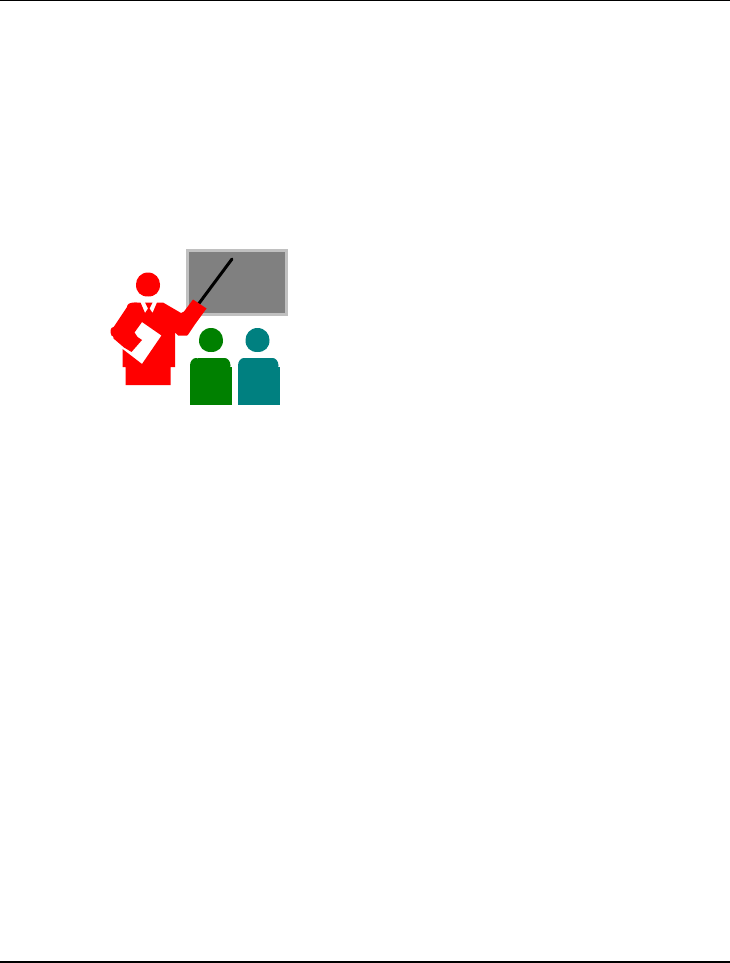
Introduction1
13
1 Introduction
Your Notebook PC is a fully Windows compatible
portable personal computer. With the latest features in
mobile computing and multimedia technology, this
notebook makes a natural traveling companion. With
leap of technology and compact, your Notebook PC
runs on a whole wide range of general business,
personal productivity, entertainment, and professional
applications. It is ideal for use in the office, at home,
and on the road.
Your Notebook PC makes an ideal choice for use in the
office, the schoolroom, at home, on the road and all
other occasions.

Notebook User Guide
14
1.1 Feature Highlight
Before we go to identify each part of your Notebook PC, we will first introduce
you to other notable features of your computer.
Processing Unit
• Your notebook runs on Intel Pentium 4/Intel Mobile Pentium 4
microprocessor. The Intel Pentium 4/Intel Mobile Pentium 4 are integrated
with 512 KB L2 Cache. Check with your dealer on the CPU type and speed.
• Fully compatible with an entire library of PC software based on operating
systems such as Windows XP.
Wireless LAN
Built-in Mini PCI Wireless LAN module (BTO)
Memory
This notebook provides two memory slots for installing DDR SDRAM 144-pin
SODIMM modules up to 2048MB using 128MB, 256MB, 512MB or 1024MB
DDR SDRAM modules.
PCMCIA
Provides one PCMCIA slot that allows you to insert one Type II card.
IEEE 1394
Provides one IEEE 1394 port for fast data transmission by external hard disk or
digital video (DV)

Introduction1
15
USB 2.0
Provides four USB 2.0 ports for fastest I/O data transmission
AGP Local Bus Architecture
Provides blazing graphics controller with nVidia chipset. AGP video local bus
and 3D Graphic Engine with maximum 64/128MB video memory
PCI Local Bus Architecture
• 32-bit PCI Enhanced IDE optimizes the data transfer between the CPU and
hard disk drives. Support ultra DMA100 PIO Mode up to PIO Mode 4, bus
mastering for LBA Scheme.
• 32-bit PCMCIA CardBus PCI technology that is also backward compatible
with 16-bit PC cards.
Audio System
Full-duplex 16-bit stereo audio system output. Sound Blaster and Sound Blaster
Pro compatible.
Flash BIOS
Flash BIOS allows you to easily upgrade the System BIOS using the Phoenix
Flash utility program.
Power and System Management
• Integrated SMM (System Management Mode) on system chipset that shuts
down components not in use to reduce power consumption. To execute
power management, you can set up the parameter in Power Options
properties by pointing your mouse to Control Panel of Windows.
• Suspend hot-key allows you to suspend the system operation instantly and
resume at the press of the power button.

Notebook User Guide
16
• System Password for User and Supervisor included on the BIOS SETUP
Program to protect unauthorized use of your computer.
1.2 Unpacking the Computer
Your computer comes securely packaged in a sturdy cardboard shipping carton.
Upon receiving your computer, open the carton and carefully remove the
contents. In addition to this User Guide, the shipping carton should also contain
the following items:
The Notebook Computer
An AC Adapter and AC Power Cord
Li-Ion Battery Pack
Utility Diskettes/CD
Hardcopy User Guide/E-book
Quick Setup Manual
Carefully inspect each component to make sure that nothing is missing and/or
damaged. If any of these items is missing or damaged, notify your dealer
immediately. Be sure to save the shipping materials and the carton in case you
need to ship the computer or if you plan to store the computer away sometime
in the future.
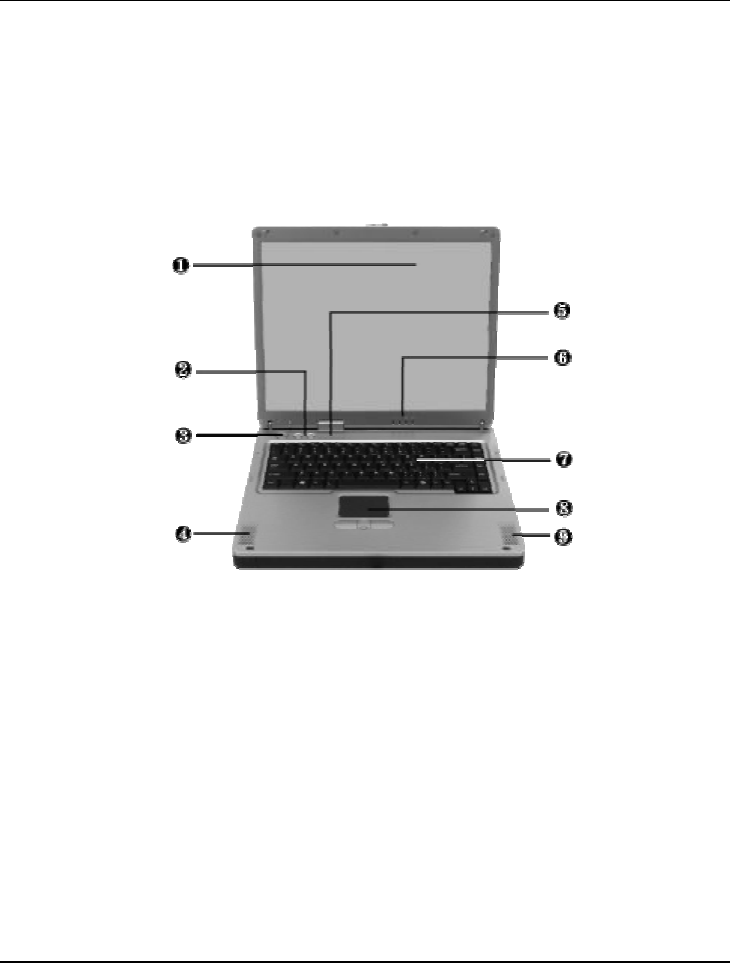
Introduction1
17
1.3 The Inside of the Notebook
The notebook computer is compact with features on every side. First, look at the
inside of the system. The following sections describe inside features.
1. Color LCD Display 2. CPU Speed Adjustment Button
3. Power On/Resume Button 4. 9. Built-in Stereo Speakers
5. Status LED Indicator
6. Power/Wireless LAN/Mail Status LED
7. Keyboard 8. Touchpad Pointing Device
• Color LCD Display
The notebook computer comes with a color LCD that you can adjust for a
comfortable viewing position. The LCD can be 14.1" or 15.0" TFT color
LCD with 1024x768 XGA (Extended Graphics Array) resolution panels or
15" TFT color LCD with 1400x1050 SXGA+ resolution. The features of the
Color LCD Display are summarized as follows:

Notebook User Guide
18
TFT color LVDS with 14.1" 1024x768 XGA or 15" 1400x1050 SXGA+
resolution panels.
Capable of displaying 16M colors (32-bit true color) on either size
panels.
LCD display control hot-keys allows you to adjust the brightness of
the LCD.
Simultaneous display capability for LCD and external desktop
computer monitor.
LCD display can be 14.1" or 15" TFT.
• CPU Speed Adjustment Button
Increased or decreased the CPU speed incrementally for the balance between
performance and power-saving.
• Power On/Resume Button
Switches the computer power on and off, or resumes whenever it is in
Suspend mode.
• Built-in Stereo Speakers
Integrated left and right mini stereo speakers for sound and audio output
for your multimedia presentations or listening pleasure.
• Status LED Indicator
Keeps you informed of your notebook computer’ s current operating status.
Description of the status icons appears in the latter part of this section.
• Power/Wireless/Mail Status LED
Keeps you informed of your notebook computer’ s current power status,
Wireless LAN and mail status. Descriptions of the status icons appear in the
latter part of this section.
• Keyboard
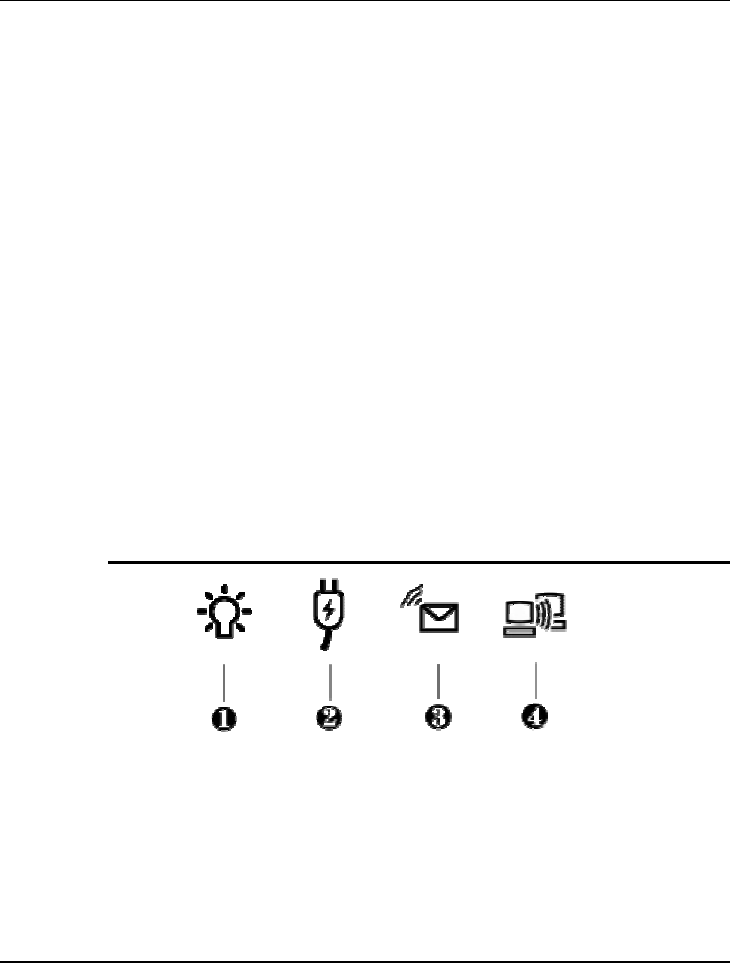
Introduction1
19
Standard QWERTY-key layout and full-sized 87/90 keys keyboard
with Windows system hot-keys, embedded numeric keypad, 10 hot
keys, inverted "T" cursor arrow keys, and separate page screen control
keys.
Wide extra space below the keyboard panel for your wrist or palm to
sit-on comfortably during typing.
• Touchpad Pointing Device
Microsoft and IBM PS/2 mouse compatible with three select buttons as one
Scroll button and two Touchpad click buttons. These three buttons array
below the Glide pad. The middle one is located with the Scroll button that
lets you execute the scroll page function. The two click buttons located at
each side support tapping selection and dragging functions. These buttons
work like a standard computer mouse. Simply move your fingertip over the
Glide Pad to control the position of the cursor. Use the selection buttons
below the Glide Pad to select menu items.
POWER/WIRELESS LAN/MAIL STATUS ICONS
1. Power Indicator 2. Battery Charging LED
3. Mail LED 4. Wireless LAN Access
• Power Indicator
Lets you know that power to the system is turned on. This LED is
positioned so that you can see the power state whether the LCD panel is
opened or closed.

Notebook User Guide
20
Lights green when the system is powered on using the AC adapter or
battery.
Lights green blinking when in Suspend to RAM. (or Suspend to Disk)
Lights orange when the battery power is low.
• Battery Charging LED
Lights to indicate battery in charging status.
Lights blue to indicate that the battery is in charging.
Lights off to indicate the battery is fully charged or no battery installed.
• Mail LED
Lights blinking blueto indicate that a new mail is arrived.
• Wireless LAN access
Lights in blue indicate that the wireless LAN module is installed. When
lights blinking blue indicate that the system is accessing or retrieving data by
wireless device.
The notebook computer uses status lights marked with icons to communicate
system status. See the following figure and list for each icon’ s meaning.
STATUS LED ICONS
The Status LED Panel keeps you informed of the notebook’ s current operating
status. Each LED is marked with an icon to designate the system status.
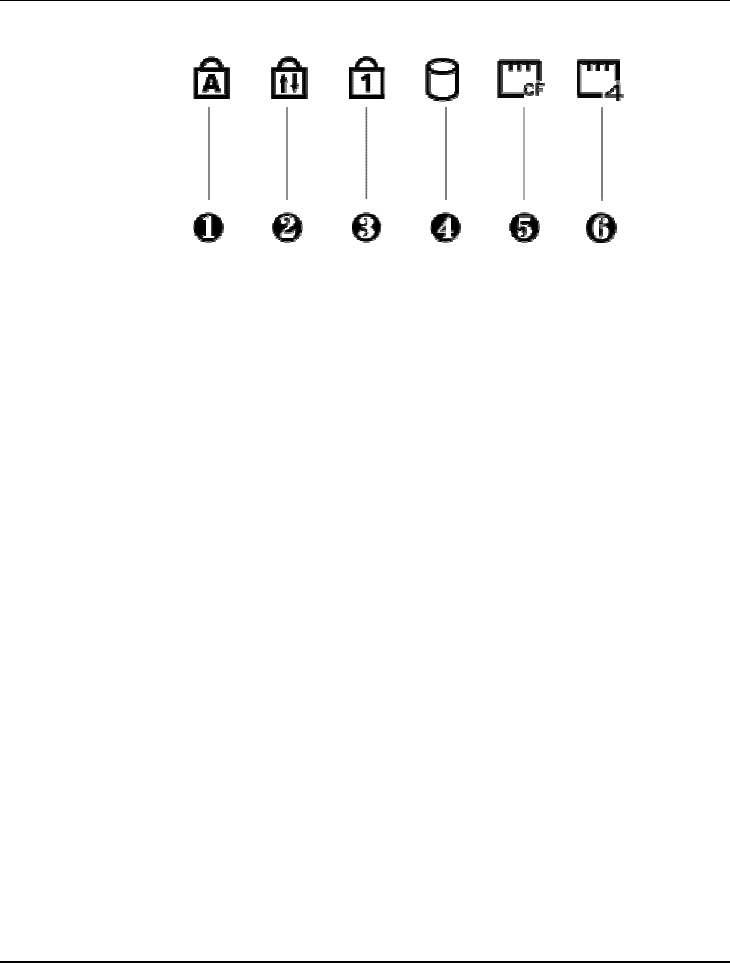
Introduction1
21
1. Caps Lock 2. Scroll Lock
3. Num Lock 4. Drive Access
5. CF Access 6. 4 in 1 flash Access
Status LED Icons
• Caps Lock
When LED in blue light indicates that the Caps Lock key on the keyboard is
activated. When activated, all alphabet keys typed in will be in uppercase or
capital letters.
• Scroll Lock
When LED in blue indicates that the Scroll Lock key on the keyboard is
activated. The Scroll Lock key has different functions depending on the
software you are using.
• Num Lock
When LED in blue light indicates that the Num Lock key on the keyboard is
activated. When activated, the embedded numeric keypad will be enabled.
• Drive Access
When LED in blue light indicates that the system is accessing either the Hard
Disk or CD/CD-RW/DVD/Combo drive.
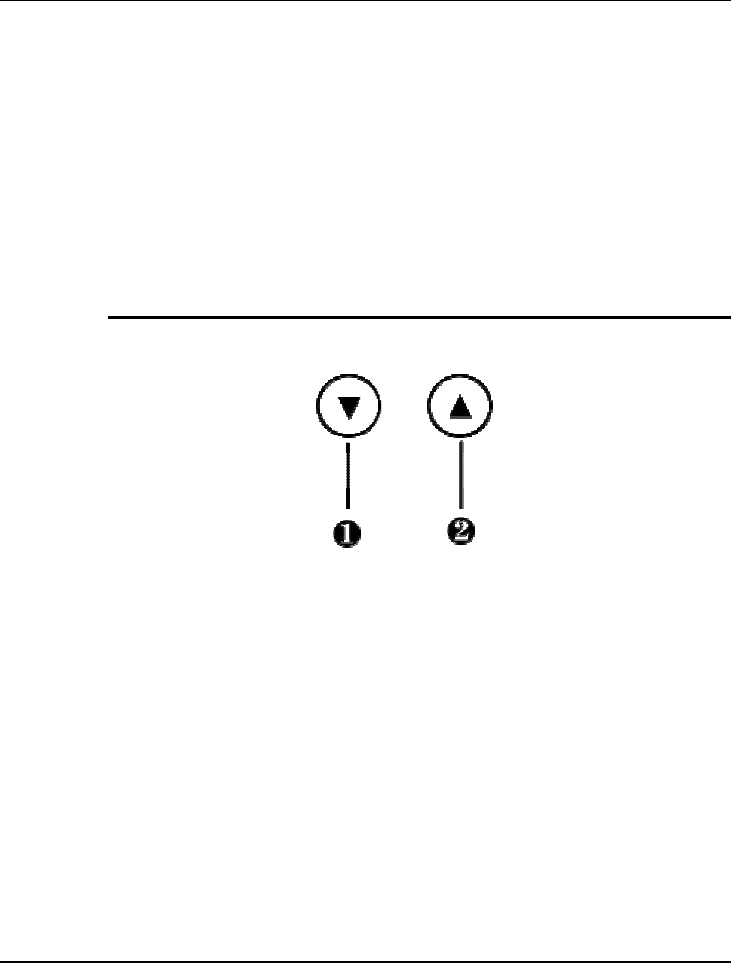
Notebook User Guide
22
• CF Access
When LED in blue light indicates that CF (Compact Flash) card is inserted
into this slot and recognized by this NB.
• 4 in 1 flash Access
When LED in blue light indicates that one of the flash card (SD, MMC,
Memory Stick, or Smart Media card) is inserted into this slot and recognized
by this NB.
THE FUNCTION OF CPU SPEED ADJUSTMENT BUTTONS
1. CPU speed down button 2. CPU speed up button
• CPU speed down button
Press this button to decrease the CPU performance speed to save power for
extending battery life and operation time.
• CPU speed Up button
Press this button to increase the CPU performance speed for highly
performance demanding program
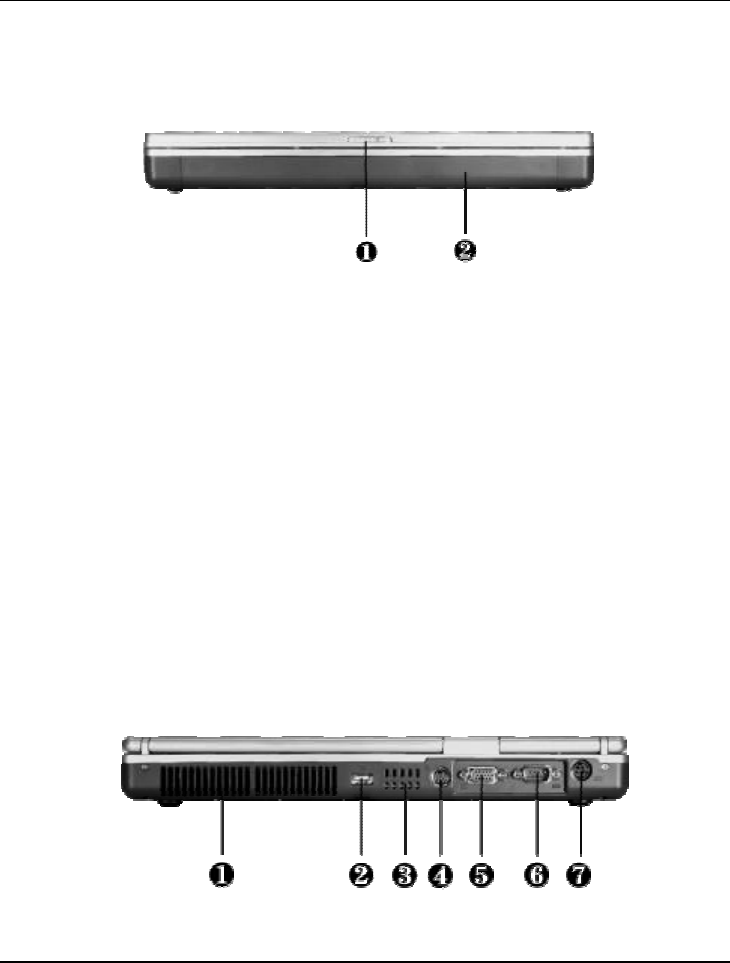
Introduction1
23
1.4 The Front Side of the Notebook
1. Cover Switch 2. Battery
• Cover Switch
The cover (LCD panel) is locked when it is closed. Slide the button right
aside to release the latch for opening the cover of the computer.
• Battery
The battery provides the power for the N/B when there is no AC power
available. Please refer to chapter 2.1 for how to attach and detach the battery.
1.5 The Rear Side of the Notebook
The system ports at the back of your notebook computer can connect various
devices (like a printer or external monitor). Each port is described as followings.
1. Air-Outlet Vent 2. USB Port 3. Air Inhalant

Notebook User Guide
24
4. TV Port 5. Monitor Port 6. COM Port
7. DC Power Port
• Air-Outlet Vent
Emits the heat out of your computer and keeps it within operating
temperature.
• USB Port
The Universal Serial Bus (USB) port allows you to connect up to 127 USB-
equipped peripheral devices (for example, printers, scanners and so on) to
your notebook computer.
• Air Inhalant
Inhale the air into your computer to keep it within operating temperature.
• TV Port
Lets you connect to a S-Video TV connector for presentation or VCD, DVD
watching.
• Monitor Port
Lets you attach an external monitor or projector for wider display. You can
run the LCD display and the external monitor simultaneously or switch it to
monitor only using the display hot-key.
• COM Port
Lets you connect a 9-pin external serial device such as a PDA, GPS or other
serial devices.
• DC Power Port
Lets you connect the AC power adapter in supplying continuous power to
your notebook and recharging the battery.
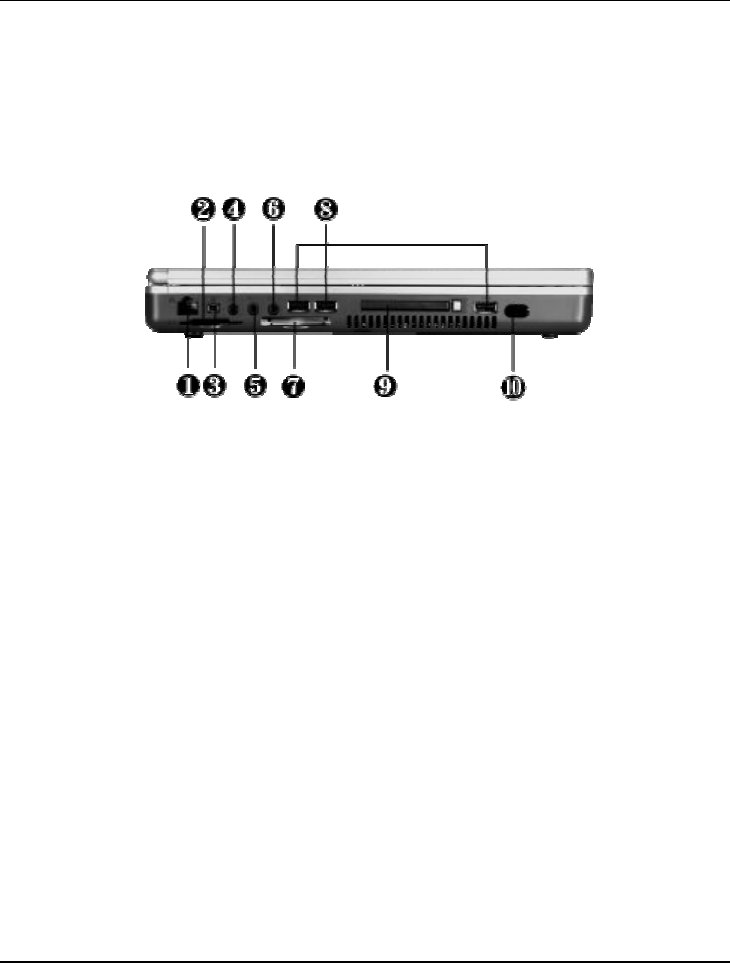
Introduction1
25
1.6 The Left Side of the Notebook
The left side of your notebook computer provides the features shown in the
following figure.
1. LAN port 2. 4 in 1 card slot
3. IEEE 1394 4. Stereo line in jack
5. Microphone jack 6. Headphone jack
7. CF card slot 8. USB port
9. PC Card slot 10. IR port
Left Side Features
• LAN Port
An internal 10Base-T/100Base-TX LAN module connects your computer to
other computers/networks through a local area network (LAN).
• 4 in 1 card slot
The card slot supports MMC, SD, Smart Media and Memory Stick flash
memory card format. You can use either of the 4 types flash memory card
for extra storage media. Please pay attention to put the copper connector at
the bottom side when you insert the flash memory card.
• IEEE 1394
IEEE 1394 port is a high speed I/O port that can transfer high levels of
data in real-time, such as external hard disk, Digital Video Camera.

Notebook User Guide
26
• Stereo Line-In Jack
Lets you connect an external audio device such as CD player, a tape deck, or a
synthesizer as an input source. Use a cable to connect to the Line-Out port
on the other audio system to record or play on this N/B.
• Microphone Jack
Allows you to connect an external microphone for monophonic sound
recording directly into your notebook computer.
• Headphone Jack
Lets you plug in a stereo headphone, powered speakers, or earphone set
with 1/8 inch phono plug for personal listening.
• CF card Slot
This card slot provides you in using CF (Compact Flash) card as extra
storage media. There is one correct side only can be accepted for this card slot.
If you cannot insert the card into the slot, please turn the card upside down
and insert it again.
• USB Port
The Universal Serial Bus (USB) port allows you to connect up to 127 USB-
equipped peripheral devices (for example, printers, scanners and so on) to
your notebook computer.
• PC Card Slot
Lets you connect various PC cards such as memory card
Supports both 3V, 5V 32-bit CardBus and 16-bit PC cards.
• IR Port
Wireless data/files transferring between your notebook computer and an IR-
equipped device or notebook computer. You can also print to an IR-
equipped printer without using cables.
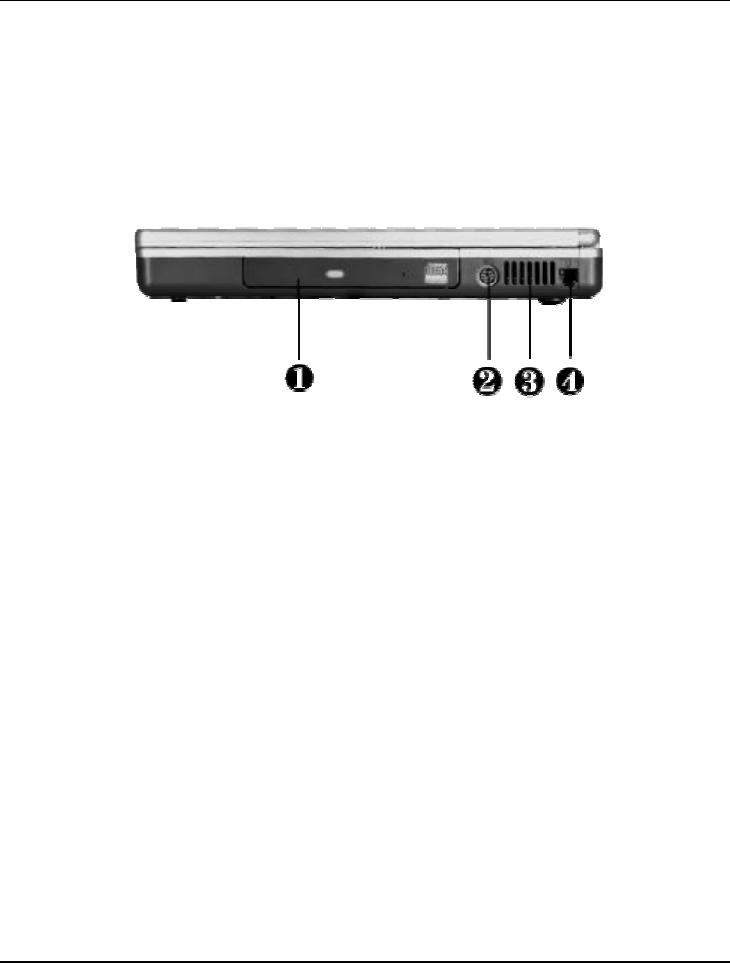
Introduction1
27
1.7 The Right Side of the Notebook
The right side of the notebook computer offers the features shown in the
following figure.
1. CD-ROM, DVD-ROM, CD-RW/DVD Combo
2. PS/2 Port 3. Air Inhalant 4. Modem Port
Right Side Features
• CD-ROM, DVD-ROM, CD-RW/DVD Combo
Allows you to load and start programs from a compact disc (CD) or a digital
video disc (DVD) and play conventional audio CDs. It also can make CD by
using CD-R or CD-RW.
• PS/2 Port
Lets you connect an external PS/2-style mouse, PS/2-style keyboard, or
PS/2-style numeric keypad to the system. With an optional Y-cable adapter,
you also can connect any combination on two of these
• Air Inhalant
Inhale the air into your computer to keep it within operating temperature.
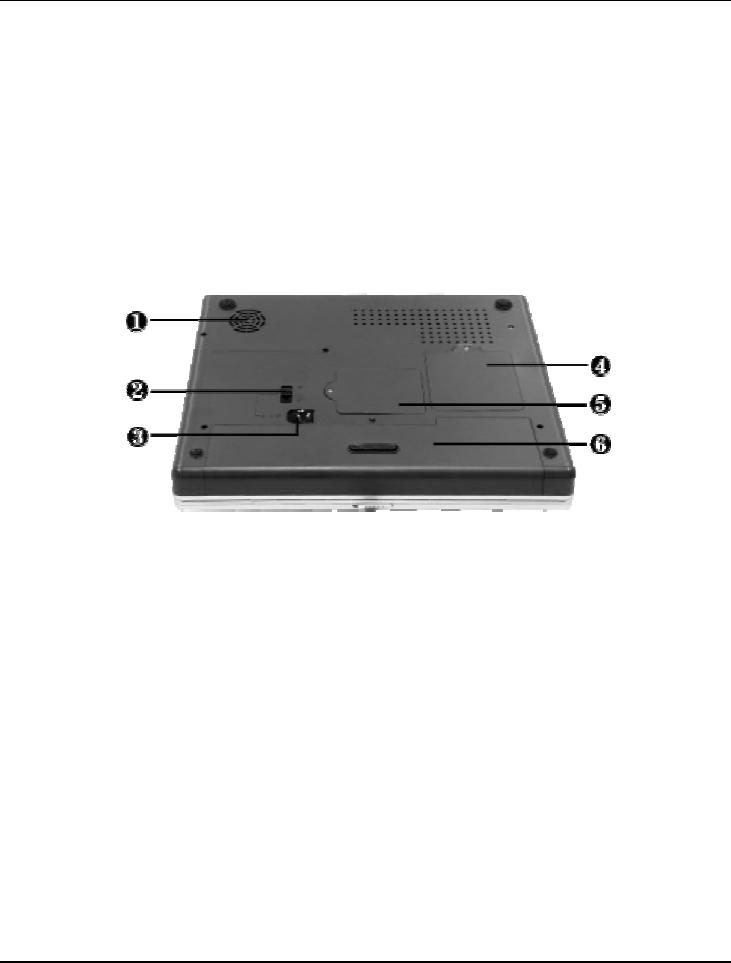
Notebook User Guide
28
• Modem Port
A 56K internal fax/data modem is installed. It keeps you connected to the
outside world through networks.
1.8 The Underside of the Notebook
The bottom of the notebook computer offers the following features.
1. Air Inhalant 2. Battery Lock Latch
3. Battery Release Latch 4. Memory Compartment
5. Wireless LAN/Modem Module Compartment
6. Battery Bay
Bottom of the System
• Air Inhalant
Inhale the air into your computer to keep it within operating temperature.
• Battery Lock Latch
Push the latch to the bottom to lock the battery bay. This action only
available when the battery release latch has located to the right side.
• Battery Release Latch
Push the latch to the left end to remove the battery pack.

Introduction1
29
• Memory Compartment
Remove the screw to find two DIMM slots. One slot is empty for upgrade
usage.
• Wireless LAN/Modem Module Compartment
This compartment is for installing Wireless LAN/Modem combo module
to enable the Wireless LAN/Modem function. It is BTO option and can be
installed only by certified dealer.
• Battery Bay
Equipped with a choice of Lithium-Ion (Li-Ion) battery pack.
1.9 Notebook Accessories
AC Adapter
The AC Adapter supplies external power to your notebook computer and
charges the internal battery pack simultaneously. The AC adapter has an auto-
switching design that can connect to any 100VAC ~ 240VAC power outlets. You
just change the power cord if you are going to use your notebook in other
countries with different connector outlets.
When you connect the AC adapter, it charges the battery whether or not the
notebook computer is powered on.
Battery Pack
Aside from the AC adapter, your computer can also be powered through the
internal battery pack. The battery pack uses rechargeable Lithium-Ion (Li-Ion)
battery cells that provide long computing hours when fully charged and power
management enabled. You should always leave the battery inside your computer

Notebook User Guide
30
even when using the AC adapter as it also acts as a back-up power supply in case
power from the AC adapter is cut off. It is also very important to have the battery
pack always charged to prevent battery cell degradation.
1.10 Notebook Options
DVD-ROM Device Pack
This device pack option is used for reading DVD or playing DVD titles. DVD-
ROM drives are also backward compatible with CD-ROM, so you can also use
any audio CDs, video CDs, photo CDs, and CD-R.
CD-RW Device Pack
This device pack can write data to CD-R or CD-RW CD for you to backup the
data.
CD-RW/DVD Combo Device Pack
This device pack can write data to CD-R or CD-RW CD for you to backup the
data and also can read DVD/CD title.

Introduction1
31
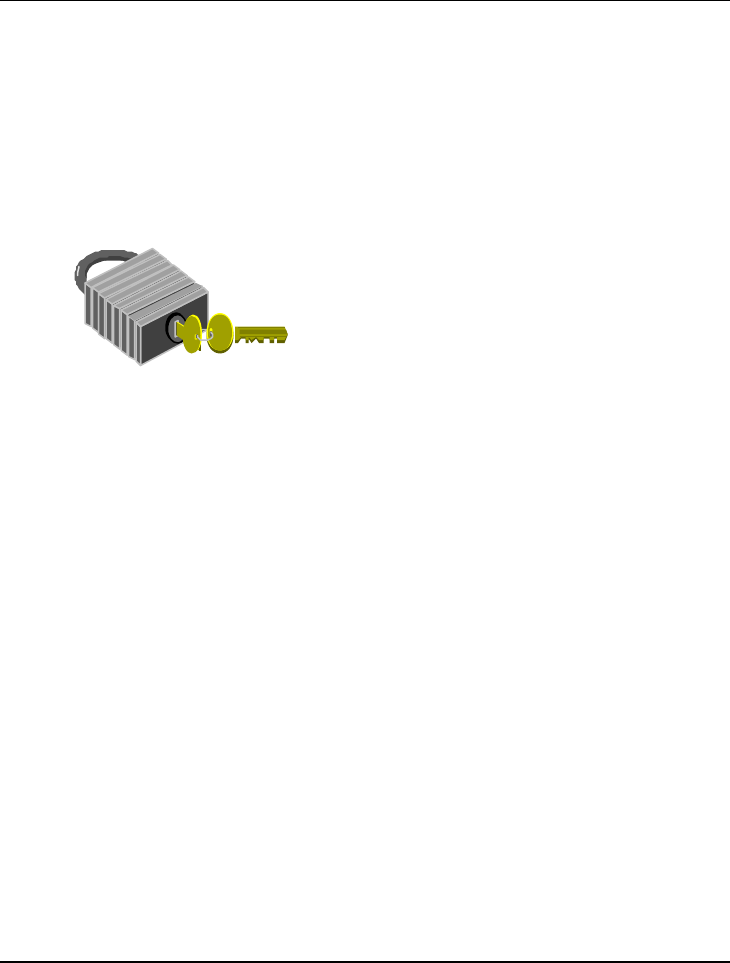
Getting Started 2
33
2 Getting Started
Your Notebook is designed and pre-configured for
easy setup and use. This chapter describes the
installation steps you should follow to get the
notebook up and running as quickly as possible.
Contact your dealer if they have pre-installed all the
needed drivers to fully operate your computer or if
there is an update on the driver installation of the
notebook.
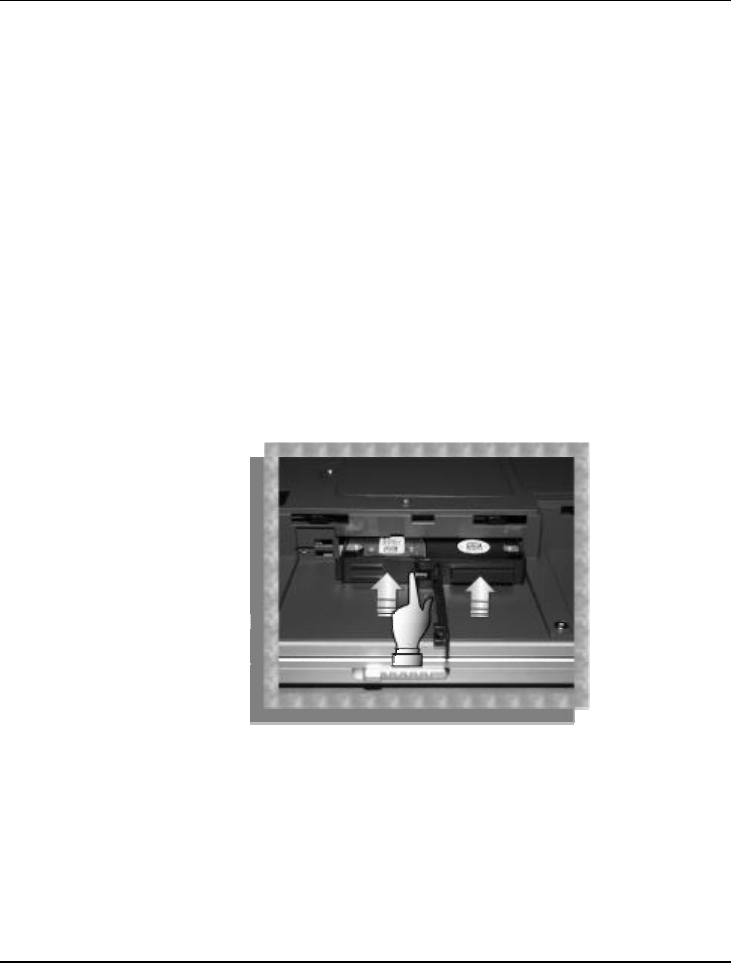
Notebook User Guide
34
2.1 Installing the Hard Disk
For safety and delivery purpose, the HDD might be separately packed from the
notebook. If it had installed by the dealer, please skip this section and refer the
next section continuously. If the HDD is packed individually, you should install
it with following procedures before using the notebook.
To install the HDD:
1. Remove the HDD's protecting package.
2. Insert the HDD with its connector toward the socket inside the battery bay.
3. Push the HDD firmly and slowly.
4. Place the locking bar and push it right side to lock the HDD firmly.
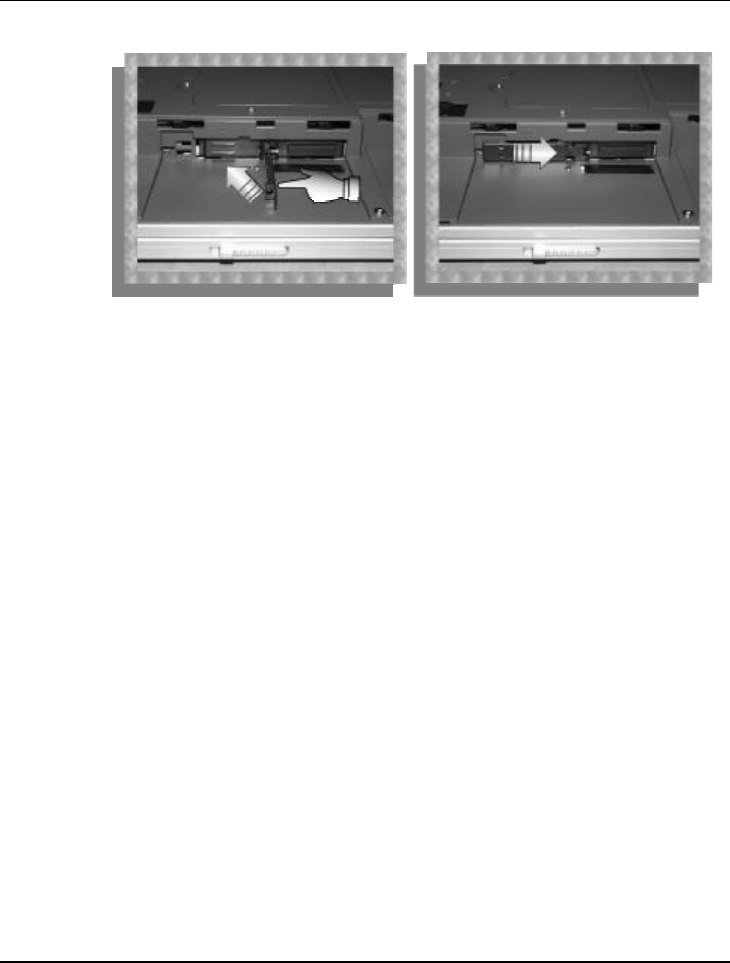
Getting Started 2
35
2.2 Using the Battery Pack
The notebook is designed to operate with one of the following power sources:
• With AC power using the AC adapter connected to an electrical outlet.
• With a Lithium-Ion (Li-Ion) battery pack.
You should use the AC adapter whenever it is possible, relying on the battery
pack only when AC power is unavailable.
Before you use your notebook computer, install and recharge the battery pack
first. The rechargeable Li-Ion battery pack allows you to operate the notebook
without an external power source. When you connect the AC power adapter, the
battery immediately starts to recharge. Normal battery charging time is 2~2.5
hours for Lithium-Ion (Li-Ion) battery pack when your computer is turned off.
For maximum battery performance, fully discharge the battery first before
recharging it when you start to use it first time. To do so, unplug the AC adapter,
turn off power management features (through Setup and Windows), and turn
on the system. Once the battery is fully discharged, plug in the AC adapter and
recharge the battery. You can also do it by using the Battery Refresh function in
BIOS setup manual that is described on chapter 6.6

Notebook User Guide
36
If you do not discharge the battery completely, it fails to accept a full recharge.
Li-Ion battery is vulnerable, do not charge it with other power adapter,
or it may cause fire or explosion.
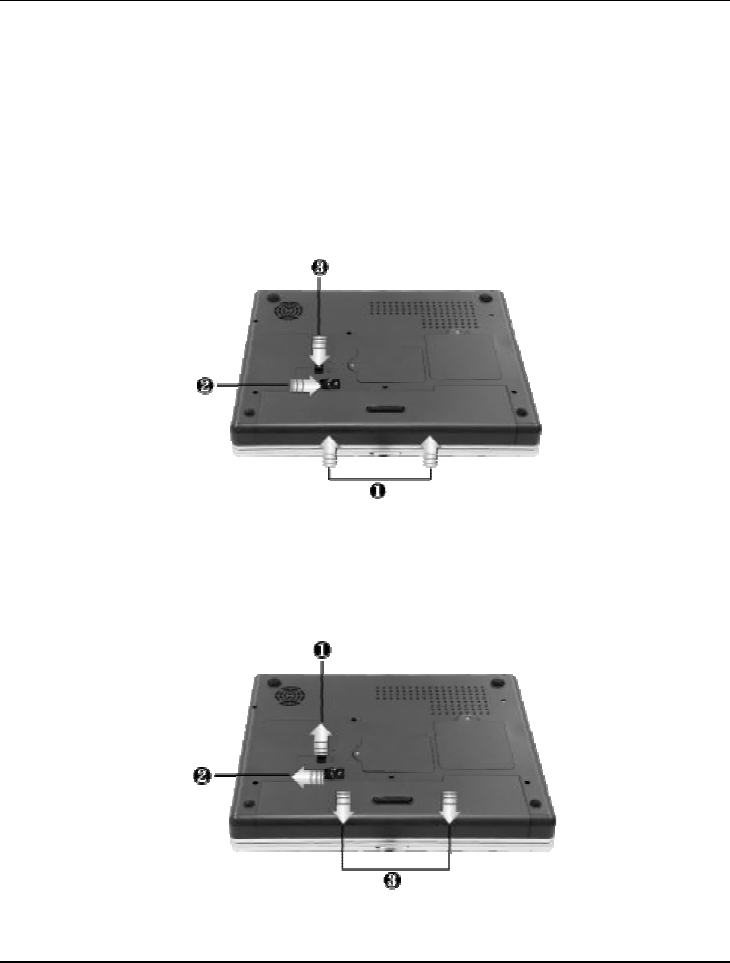
Getting Started 2
37
Installing the Battery Pack
This notebook provides the most convenient way to install the battery pack into
your computer. To install the battery, first orient the extended nose directed
toward the compartment, then following the sequence as shown in the figure
below.
Removing the Battery Pack
To remove the battery pack, slide the related latch and then take out the battery
pack with your finger as the sequence shown in the figure below.

Notebook User Guide
38
Replacing the Battery Pack
When your notebook estimates that the battery only has enough charge to
continue for a few minutes, it will alert you with a battery low warning beep. If
you are consuming a lot of power by using the audio system, the PCMCIA slots,
the hard drives, and CD/DVD/CD-RW/Combo drive, your notebook might
run out of charge much sooner than you expect. You should always respond to
the battery low indication by connecting to AC power or turning off your
notebook, or suspending your notebook to disk. If you do not do so, the
notebook will automatically suspend to disk and turn off. The contents of the
memory will store in the hard disk drive. You will be unable to restart the
notebook until you have connected to the AC adapter or installed a charged
battery. To replace the battery pack, refer to the previous sections on "Installing
the Battery Pack" and "Removing the Battery Pack."
For Window Me/2000/XP, the suspend mode (Hibernate or Standby)
can be chosen at Power Options of Windows's Control Panel)
Be sure to save your data before replacing the battery pack or
connecting the AC adapter. Failure to do so can result in data loss.
EXTENDING BATTERY LIFE
It is important to be aware of the simple things for extending the life of the
system main battery while you are on the road. You should find a working place
where the external lighting is not too bright and turn down the screen brightness.
Also, you can choose the available mode on the Power Management item of the
Control Panel in Windows.
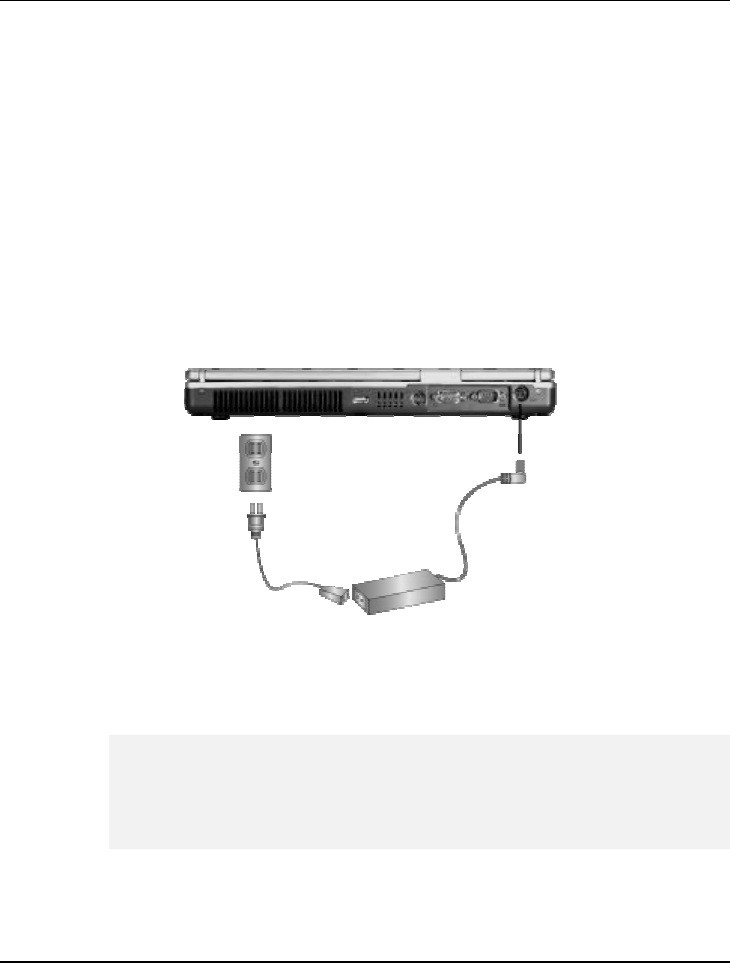
Getting Started 2
39
2.3 Connecting the AC Power Source
The AC adapter provides external power source to your computer and charges the
internal battery pack at the same time. The AC adapter also has an auto-switching
design that can connect to any 100VAC ~ 240VAC power outlets.
To connect the power adapter:
1. Plug the AC power cord into the power socket of the AC power adapter.
2. Plug the other end of the AC power cord to a live AC wall outlet.
3. Plug the connector of the AC adapter to the DC-IN port found at the back
of the computer.
Whenever possible, it is advisable to always have the AC adapter
connected to the notebook and the battery pack installed. This ensures
continuous power supply and prevents any data loss incurring from
sudden power breakdown.
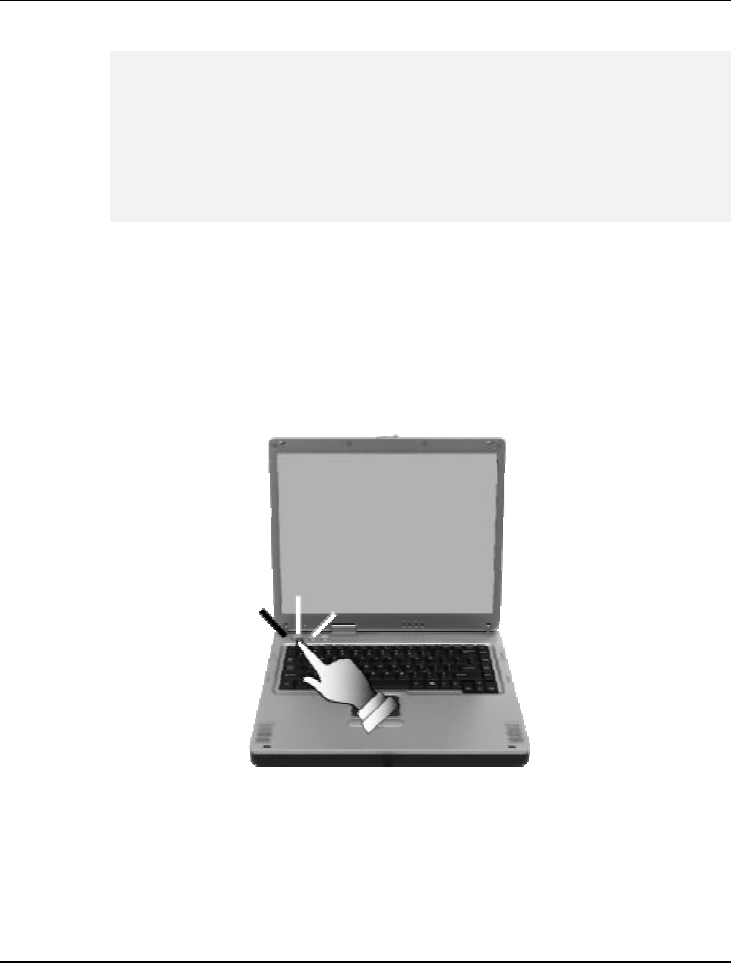
Notebook User Guide
40
For the power supply of this equipment, an approved power cord has
to be used.
Make sure the socket and any extension cord(s) you use can support
the total current load of all the connected devices.
Before cleaning the computer, make sure it is disconnected from any
external power supplies (i.e. AC adapter).
2.4 Starting Your Computer
The Power/Resume button is found on the top of the base unit. Press the
Power/Resume button to start your computer and check that if the Power LED
turns on.
After a few seconds, the computer’ s display will turn on and your computer will
begin to execute the Power On Self Test or POST to check if all system
components are running properly. Any error found during the test will be
displayed on the screen and may generate short beep sound as well.

Getting Started 2
41
After the test, the screen will also display a message "press <F2> to enter
SETUP". You don’ t need to run this program at the moment as your dealer
already made the necessary settings for your computer optimal operation. Refer to
Chapter 6 on running the SETUP program later.
After the test has completed, your computer will start to search and boot up the
operating system from your hard drive. The notebook computer normally comes
with a Windows operating system pre-installed in your hard drive. Consult the
Windows manual on how to use the program. If not, contact your dealer for
assistance.
2.5 Adjusting the Display Controls
The LCD brightness adjustment is controlled by <Fn> +<F8> and <Fn> +
<F9>keys respectively. You need to press these hot-key controls after powering
on your notebook to suit your viewing pleasure.
The Brightness hot-key control adjusts the brightness on the LCD. The
brightness hot-key control will not set the LCD completely dark or bright; it
provides sufficient lighting to the LCD to match the external lighting of the
surrounding. The brighter the room, the more you need to increase the
brightness of the LCD.
2.6 Installing the Notebook Device
Drivers
If you already have an operating system installed into your notebook computer, it
is best to install the needed device drivers for using the built-in devices of your
computer. Before installing the drivers, check with your dealer first if they have

Notebook User Guide
42
already installed all the drivers along with the operating system. If not, follow the
procedures below:
INSTALLING WINDOWS XP FROM CD/DVD/CD-
RW/COMBO DRIVE
To install Windows XP directly from your CD-ROM or DVD-ROM, please go
to Boot menu of BIOS setup menu. Use arrow key to select "CD-ROM Drive",
then use "+" or "-" to move it to the top. Go to Exit menu and select "Exit
Saving Changes". Accordingly, insert the Windows XP installation CD into
CD-ROM drive with following the instructions on the screen to finish the
installation.
ENABLE DMA CHANNEL FOR BEST PERFORMANCE
This Notebook supports DMA function for fastest data bus transmission. The
Windows system does not enable this function after you had installed the
Windows system. You must enable this function manually to make this
notebook running smoothly, especially in music listening and DVD, VCD
playback.
Enable DMA for Windows XP
1. Please click the following buttons with the procedure Start --> Setting-->
Control Panel --> System --> Hardware --> Device Manager.
2. Select and click IDE ATA/ATAPI Controller, you will find Primary IDE
Channel and Secondary IDE channel. Please click Primary IDE Channel
first.
3. Click Advanced setting Tab. Please change the selection of Transfer Mode
to DMA if available on both Device 0 and Device 1.

Getting Started 2
43
4. Return to previous level, please change the setting of Secondary IDE
Channel as above.
5. Restart your notebook to let the setting take effect.
INSTALLING THE AGP DRIVER
For the best and fast performance of video AGP, please install the driver of the
AGP. Follow the procedures indicated below to install the AGP driver.
Installing AGP driver for Windows XP
1. Click the Start button, then point to Run. The Run dialog box appears.
2. Click the Browse button and specify the directory as.
"E:\Drivers\WinXP\AGP\Setup.exe".
3. Implement the setup program to install this driver. The Welcome dialog
box appears.
4. Click Next to process the further step continuously when screen displays
this command.
5. Press Finish to restart your system.
INSTALLING THE VGA DEVICE DRIVER
Following is the procedure for installing the Video Accelerator 3D Adapter VGA
driver to your computer:
Installing VGA device driver for Windows XP
1. Click the Start button, then point to Run. The Run dialog box appears.
2. Click the Browse button and specify the directory as.
"E:\Drivers\WinXP\VGA\Setup.exe".

Notebook User Guide
44
3. Implement the setup program to install this driver. The Welcome dialog
box appears.
4. Click Next to process the further step continuously when screen displays
this command.
5. Press Finish to restart your system.
INSTALLING THE LAN DEVICE DRIVER
Please follow the procedures below for installing the LAN driver:
Installing LAN driver for Windows XP
1. Click the Start button, then point to Run to appear the Run dialog box.
2. Click the Browse button to specify the directory as
"E:\Drivers\WinXP\LAN\Setup.exe"
3. Execute the setup program and then the Welcome dialog box appears.
4. Click Next button to start installing.
5. Click Finish to restart your system.
INSTALLING THE AUDIO DEVICE DRIVER
Your notebook computer uses the Realtek Audio controller.
Installing Audio device driver for Windows XP
1. Click the Start button, then point to Run. The Run dialog box appears.
2. Click the Browse button and specify the directory as.
"E:\Drivers\WinXP\Audio\Setup.exe"
where the audio driver is located
3. Implement the setup program to install this driver. The Welcome dialog box

Getting Started 2
45
appears.
4. Click Next to process the further step continuously when screen displays this
command.
5. Press Finish to restart your system.
INSTALLING EZBUTTON DRIVER
Following is the procedure for installing the Internet and e-mail buttonkeys.
Installing EzButton driver for Windows XP
1. Boot Windows from your hard disk and insert the disc containing the
EzSystem driver for Windows.
2. Click the Start button and then click Run. In the Run dialog box, click
Browse button and navigate to the directory as
"E:\Drivers\WinXP\EzButton\EzButton.exe"
where the EzButton driver is located.
3. The system may prompt you the message to restart the computer to finish
the installation.
INSTALLING EASY MAIL LIGHT DRIVER
Installing Easy Mail Light for Outlook 98/2000/2002 driver on Windows
XP
1. Boot Windows from your hard disk and insert the disc containing the Ez
Mail Light driver.
2. Click the Start button, then click Run. In the Run dialog box, click Browse
button and navigate to the directory as
"E:\Drivers\WinXP\EzMail\EzMail.exe".

Notebook User Guide
46
3. Run the execution file for installing the EZ Mail Light driver, and then click
Finish after completes the installing procedure.
INSTALLING SYNAPTICS - TOUCH PAD DRIVER
Installing Synaptics - Touch Pad driver for Windows XP
1. Click the Start button, then point to Run to appear the Run dialog box.
2. Click the Browse button to specify the directory as
"E:\Drivers\WinXP\Touch Pad\Setup.exe"
3. Execute the setup program and then select the Welcome dialog box
appears.
4. Select the language version that you want to install and then click "OK" to
continue.
5. Click Next button several times.
6. Click Finish to restart your system.
INSTALLING THE FIR (FAST IR) DEVICE DRIVER
Your notebook computer uses the Fast IR controller.
Installing Audio device driver for Windows XP
1. Click the Start button, then point to Run. The Run dialog box appears.
2. Click the Browse button and specify the directory as.
"E:\Drivers\WinXP\FIR\Setup.exe".
3. Implement the setup program to install this driver. The Welcome dialog
box appears.
4. Click Next to process the further step continuously when screen displays

Getting Started 2
47
this command.
5. Press Finish to restart your system.
INSTALLING THE IDE DEVICE DRIVER
Your notebook computer uses the advanced IDE controller. Installing the driver
will enhance the stability and performance.
Installing IDE device driver for Windows XP
1. Click the Start button, then point to Run. The Run dialog box appears.
2. Click the Browse button and specify the directory as.
"E:\Drivers\WinXP\IDE\Setup.exe".
3. Implement the setup program to install this driver. The Welcome dialog
box appears.
4. Click Next to process the further step continuously when screen displays
this command.
5. Press Finish to restart your system.
INSTALLING THE CARD READER DEVICE DRIVER
Your notebook computer uses the advanced card reader controller. Installing the
driver will enhance the stability and performance
Installing IDE device driver for Windows XP
1. Click the Start button, then point to Run. The Run dialog box appears.
2. Click the Browse button and specify the directory as.
"E:\Drivers\WinXP\Card Reader\Setup.exe".

Notebook User Guide
48
3. Implement the setup program to install this driver. The Welcome dialog
box appears.
4. Click Next to process the further step continuously when screen displays
this command.
5. Press Finish to restart your system.
2.7 Turning off Your Computer
If you are not going to use the computer for a while, it is best to turn off the
power of the computer for longer use. Before turning off the power, you need to
close first all application programs and shutdown the operating system.
After turning off the computer, make it a habit to leave the LVDS panel open for
a while whenever used for an extended period of time. This allows the inside
parts of the computer to cool off. Closing the panel will force the heat up against
the LCD screen, which may degrade the LCD when done regularly. More
importantly, never close the LVDS panel for a long period of time when
computer is on and power saving features are disabled.
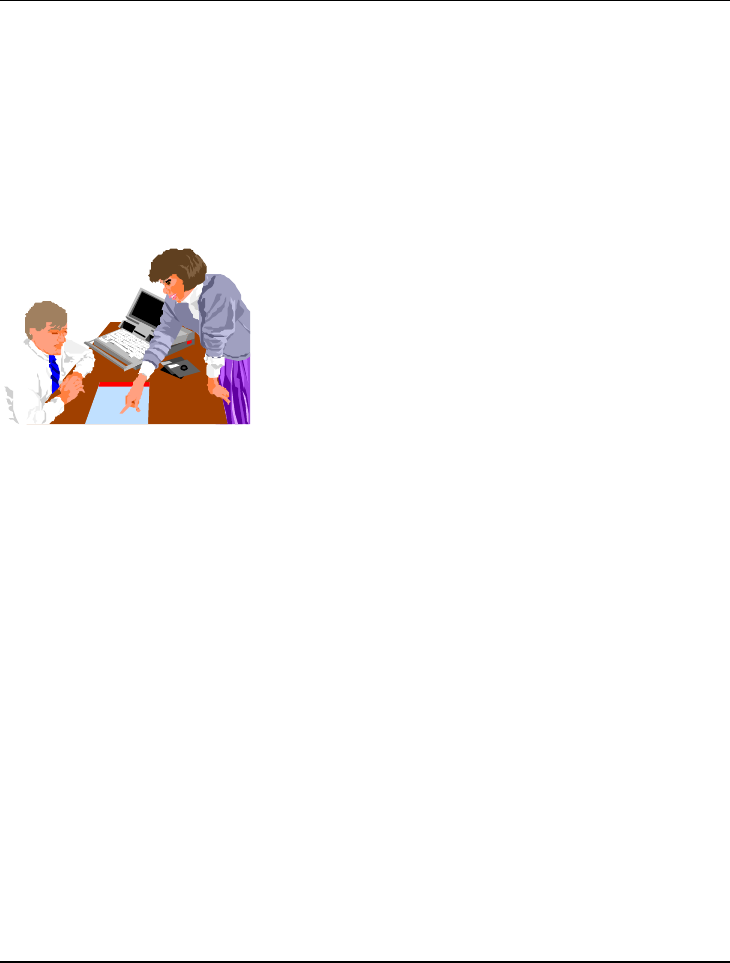
Using Your Notebook 3
49
3 Using Your Notebook
This chapter describes how to operate the standard built-
in features of the notebook that you normally would use in
your day-to-day computer work. If you are new to
computers and to your operating system, you also need to
read the manual for the operating system on how to work
with your computer. It is very important to familiarize
yourself well with the operating system. The succeeding
chapters not only guide you to go beyond the basics, but
also try other exciting features.

Notebook User Guide
50
3.1 Starting Your Operating System
The operating system is a must ingredient in using your computer. Without an
operating system, it is like playing chess without the chessboard. It is the
platform for all your software application programs to run on. The most popular
operating system today is Microsoft Windows. You should have installed one
operating system by your dealer unless you are an expert computer user and
would need a more powerful operating system. If you have an operating system
already installed in your computer, then you would be up and running after you
power on your computer and boot up the system. Check your operating system
manual on how to run it.
3.2 Understanding the Keyboard
Functions
Your notebook computer is equipped with an 84/88 keys keyboard that provides
all the functionality of a full-sized 101 or 102-key IBM keyboard. Aside from the
standard typewriter-layout keyboard of your computer, there are a number of
extra features and function controls on the built-in keyboard including Windows
system hot keys.
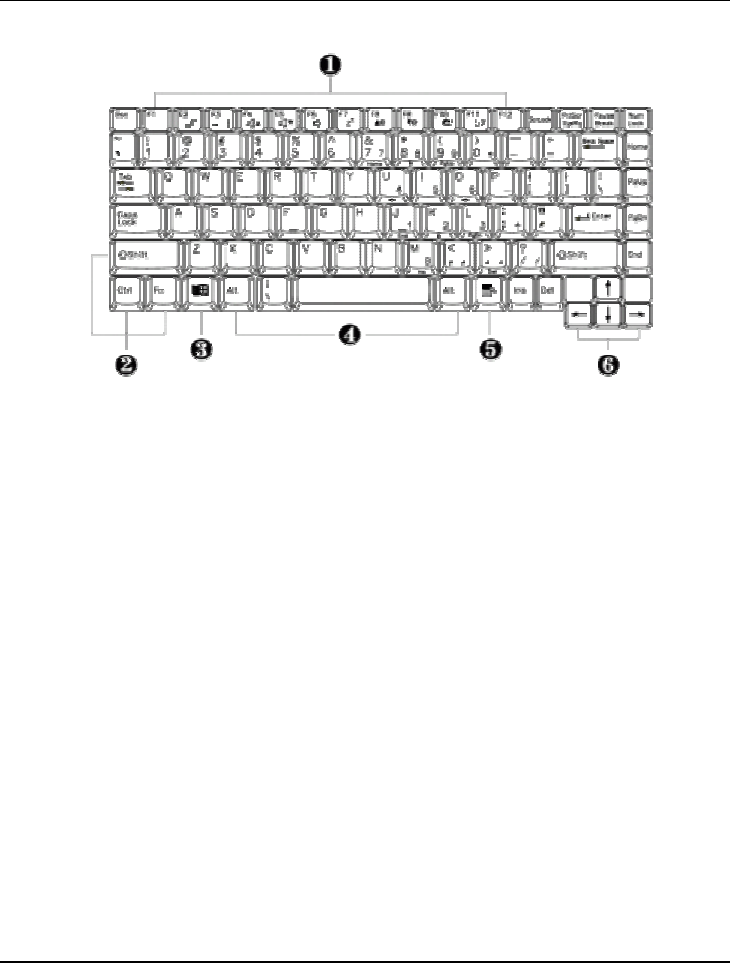
Using Your Notebook 3
51
1. Function Keys 2. Control Keys
3. Windows Start Menu Key 4. Control Keys
5. Windows Shortcut Key 6. Cursor Control Keys
Keyboard
Key features and operations are described below:
• Function Keys
Function keys are application-driven, like F1 through F12 can be found on
the keyboard. These keys work together with the Fn key to activate special
functions. Some keys (printed in blue on keypad) are preprogrammed with
dual functions.
• Control keys —Ctrl,Alt,Fn, and Shift are controls used in conjunction
with other keys to change their functions. To use control keys, press and
hold the control key while pressing another key. For example, "Press Ctrl-C"
means to hold down the Ctrl key and type the letter C. Key combinations
work especially to the application you are running.

Notebook User Guide
52
• Windows keys
Use the following two keys to facilitate your work:
Start Menu key
Displays the Start menu.
Shortcut/Application key
Provides quick access to shortcut menus. This key acts like a right
mouse button.
• Cursor Control keys
Cursor control keys let you position the cursor on the screen where you
want. In the screen, the cursor is a blinking underline, block, or vertical bar
depending on the application. The cursor indicates where the next text typed
is inserted.
• Typewriter keys
Typewriter keys (also called alphanumeric keys) are used to enter text and
characters. Keys with blue print on them behave differently when combined
with control keys.
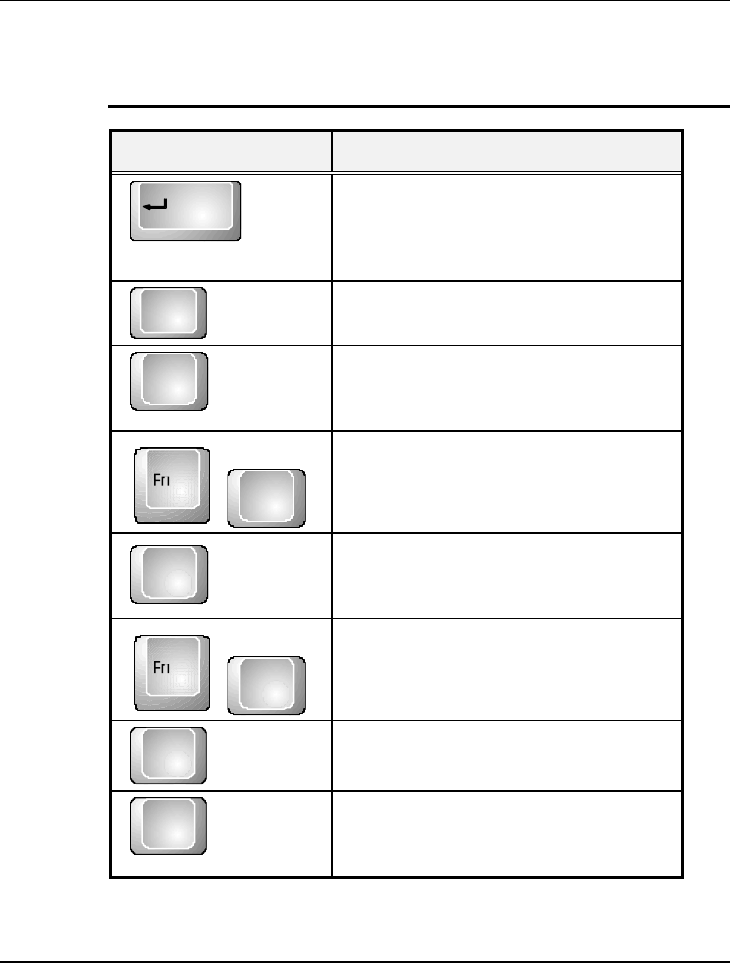
Using Your Notebook 3
53
BASIC KEYBOARD FUNCTIONS
Keypad Function Description
˘́̇˸̅
<Enter> key. Execute a command. Within
many text editing application programs,
the <Enter> key inserts a hard carriage
return, just like what ordinary typewriter
does.
˘̆˶ <Esc> key. Press this key to cancel or
escape from a command or function.
˦̌̆˥̄
ˣ̅̇ ˦˶
<PrtSc> key. Known as the Print Screen
key. Press this key to map the whole screen
to share memory for your specific usage.
+
˦̌̆˥̄
ˣ̅̇ ˦˶
<SysRq> key. Used for multitasking
operating system.
˕̅˸˴˾
ˣ˴̈̆˸
<Pause> key. Press this key to temporarily
halt execution of a command. Pressing any
other key to resume execution of a
command.
+
˕̅˸˴˾
ˣ˴̈̆˸
<Break> key. Press this key to temporarily
halt execution of a command. Pressing any
other key to resume execution of a
command.
˜́̆ <Ins> key. Known as the Insert key. Press
this key to toggle the keyboard data entry
from insert to type over mode.
˗˸˿ <Del> key. Known as the Delete key. Press
this key to delete the character to the right
of the cursor, or delete marked texts or
items.
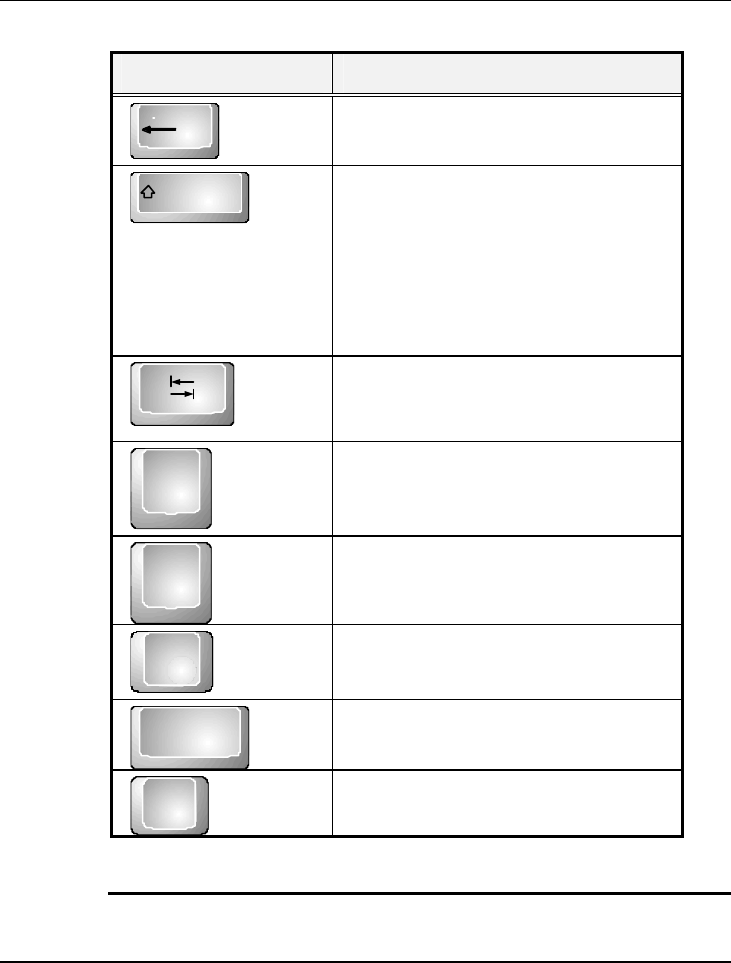
Notebook User Guide
54
Keypad Function Description
˕˴˶˾̆̃˴˶˸
<Backspace> key. Press this key to delete
the character to the left of the cursor.
˦˻˼˹̇
<Shift> key. Press this key in combination
with alphabet letters to produce uppercase
letters in typing. Use this key in
combination with those two-character keys
(found on the second row of the keyboard)
to produce the upper marked keys. Also
used in most application program in
combination with other keys to execute a
certain command.
˧˴˵
<Tab> key. Press this key to move the
cursor to the next tab stop on the right.
This key works much the same as in
ordinary typewriter.
˖̇̅˿ <Ctrl> key. Known as the Control key.
Used in most application program in
combination with other keys to execute a
certain command.
˔˿̇ <Alt> key. Known as the Alternate key.
Used in most application program in
combination with other keys to execute a
certain command.
ˡ̈̀
˟̂˶˞
<Num Lock> key. Activates the embedded
15-key numeric keypad. The keys are color
coded blue.
˖˴̃̆
˟̂˶˾
<Caps Lock> key. Used in most
application program to always activate
uppercase alphabet characters.
˦˶̅˟̂˶˞
<Scroll Lock> key. Used in most
application program to scroll the screen
without having to move the cursor.
CURSOR CONTROL KEYS
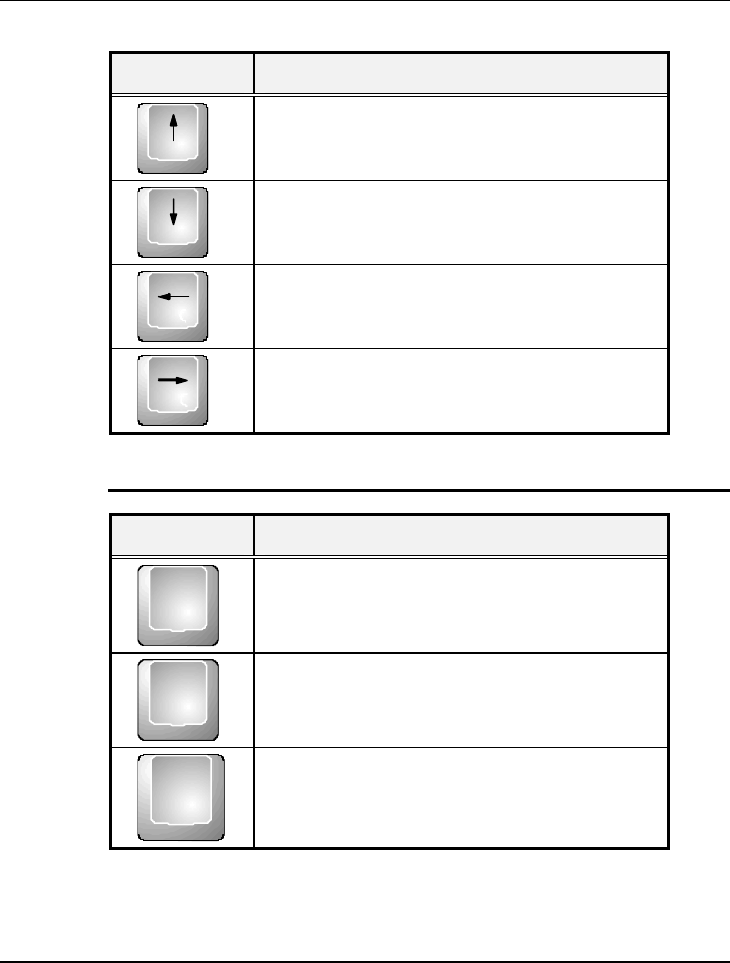
Using Your Notebook 3
55
Keypad Function Description
Up arrow key. Moves the cursor up one line at a
time.
Down arrow key. Moves the cursor down one line
at a time.
Left arrow key. Moves the cursor to the left one
space at a time.
Right arrow key. Moves the cursor to the right
one space at a time.
SCREEN CONTROL KEYS
Keypad Function Description
˛̂̀˸
<Home> key. Moves the cursor to the beginning
of a screen or line.
ˣ˺˨̃
<PgUp> key. Moves the cursor up one screen at a
time
ˣ˺˗́ <PgDn> key. Moves the cursor down one screen at
a time
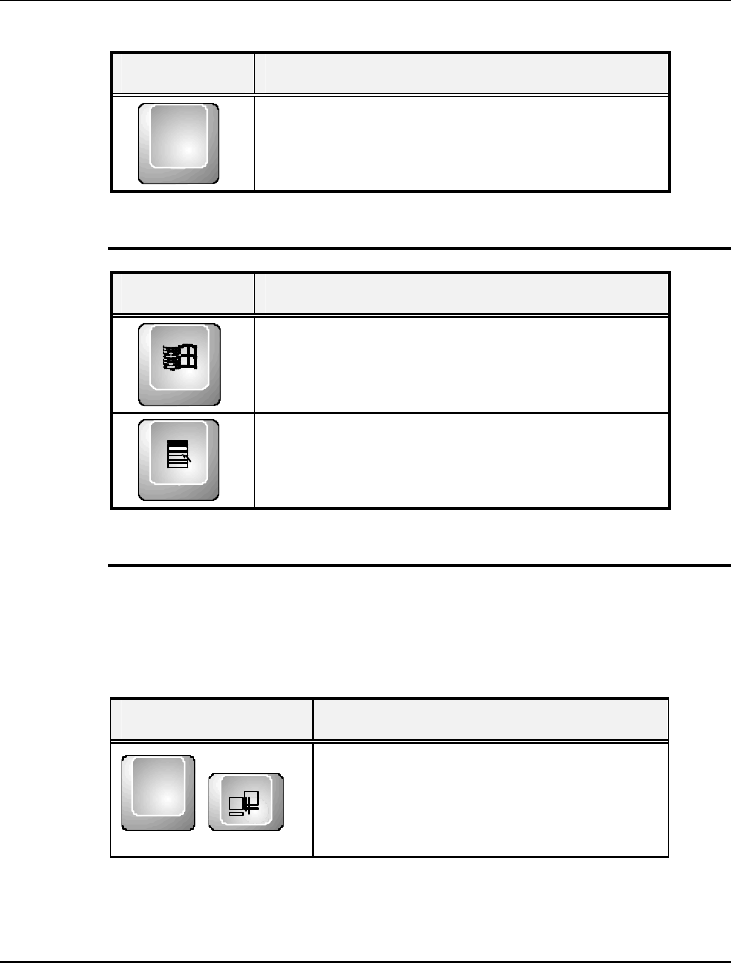
Notebook User Guide
56
Keypad Function Description
˘́˷
<End> key. Moves the cursor to the end of a
screen or line.
WINDOWS HOT KEYS
Keypad Function Description
<Start> key. Pulls up the Windows Start menu.
<Right Click> key. Performs a mouse right-click
function for Windows system.
SPECIAL FUNCTION KEYS
The notebook has special system function keys that activate key serving dual
functions. When pressed in conjunction with the <Fn> key, these keys set
specific system parameters and are sometimes referred to as "hot keys".
Keypad Function Description
Fn
+
˙˅
Enable or Disables the built-in wireless
LAN.
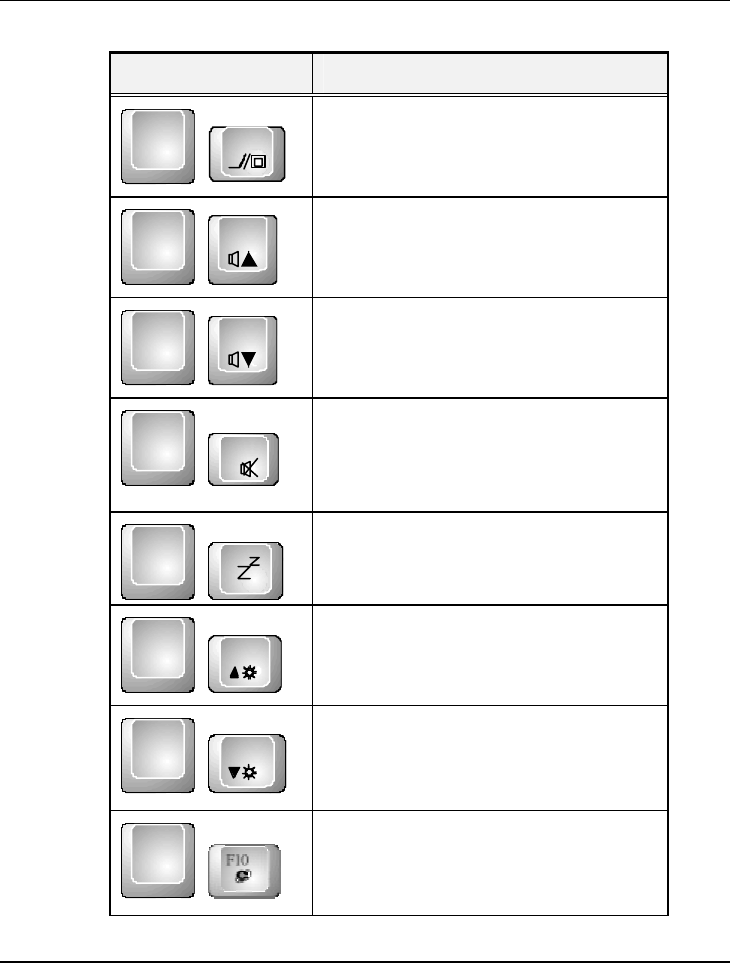
Using Your Notebook 3
57
Keypad Function Description
Fn +˙ˆ
Switches display between LCD, CRT, or
LCD and CRT simultaneously.
Fn +˙ˇ
Increases the audio volume of the
notebook incrementally.
Fn +˙ˈ
Decreases the audio volume of the
notebook incrementally.
Fn
+
˙ˉ
Enable or Disables the built-in system
speaker.
Fn
+
˙ˊ
Activate or deactivate the sleep mode.
Fn +
˙ˋ
Increases the brightness of LCD display
incrementally.
Fn
+
˙ˌ
Decreases the brightness of LCD display
incrementally.
Fn
+
Activate the Internet connection.

Notebook User Guide
58
Keypad Function Description
Fn
+
Activate the Mail connection.
3.3 Using the Glide Pad Pointing
Device
Your computer comes with a built-in Glide Pad pointing device that is found on
the center of the palm-rest surface.
The Glide Pad offers a number of options that let you customize how it
functions. To access these options, locate the Control Panel and double click on
the Mouse icon. The options let you control the size and color of the cursor,
cursor speed, the accepted double-click speed, and selection button orientation.
The Glide Pad works a mouse pointing device replacement that is used under
Windows-based operating system. You can use the standard Microsoft driver
that is compatible with the Glide Pad device and is normally used under
Windows-based operating system. However, if you want to utilize the added
features of the Glide Pad, you may want to try installing its own device driver that
comes with added utilities for enhancing the function of the device.
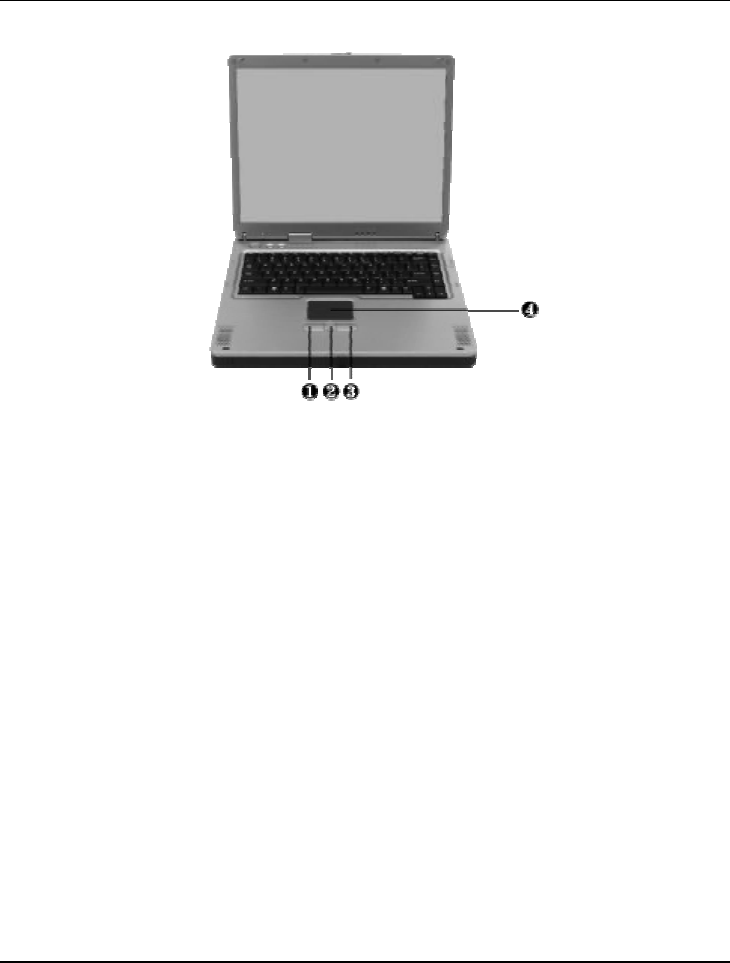
Using Your Notebook 3
59
1. Left Selection Button 2. Scroll Button
3. Right Selection Button 4. Glide Pad
Glide Pad Features
Here how to use the Glide Pad pointing device:
1. The rectangular surface acts like a miniature duplicate of your display screen.
To move the mouse cursor, place the finger lightly on the sensor pad and
move in the desired direction. If you reach the end of the pad, lift your finger
and place it back down on the other side of the pad.
2. To select an item, click on the item by pressing the left button control or by
simply tapping on the surface once. A light, quick tap always works best. To
execute an item, click the left button twice or do a quick double tap on the
surface.

Notebook User Guide
60
3. To simulate holding the mouse button down (dragging an icon or
selection), use the tap-and-drag gesture. This feels much like a double-click,
except that the finger remains on the pad after the second tap: Tap, lift, tap,
hold and move. The simulated button remains held as long as the finger
remains on the pad.
4. To scroll up or down the screen, just slide up or down the scroll button to
move the screen up or down.
Avoid spilling any liquid on the Glide pad surface and always keep the
Glide pad surface and pointing finger dry from sweat built-up. Also do
not expose Glide pad to any magnetic source object.
3.4 Configuring Your Screen Display
The VGA display function of your notebook is based on a high performance
AGP local bus controller and is fully IBM VGA compatible. This controller offers
a large set of extended functions and higher resolutions especially useful when
you are connecting an external high-resolution and high-frequency CRT or LCD.
Please Refer to Section 6 " Installing the Notebook Device Drivers" of Chapter 2
in this manual for the procedures on how to install the VGA device driver under
Windows. After installing the VGA driver, you would then configure the display
resolution or screen size to match your LCD display panel. This notebook
computer model provides 1024x768 as well as 1400x1050 LCD panels. You
would also probably want to set the amount of color output to display sharper
images and photos.
POSSIBLE DISPLAY CONFIGURATIONS
The table below shows you the possible display resolution you can set when
using either the LCD display or the external monitor (CRT):

Using Your Notebook 3
61
Display Possible Resolution Maximum Colors
1024x768
XGA LCD
640x480
800x600
1024x768
16 million colors
16 million colors
16 million colors
1400x1050
SXGA+ LCD
640x480
800x600
1024x768
1400x1050
16 million colors
16 million colors
16 million colors
16 million colors
CRT Only 640x480
800x600
1024x768
1152x768
1280x1024
1400x1050
16 million colors
16 million colors
16 million colors
16 million colors
16 million colors
16 million colors
65,536 or 64K colors is also equivalent to 16-bit high color while 16
million or 16M colors is equivalent to 32-bit true color.
You can use the <Fn> + <F3> hot-key to switch the display between
LCD only, CRT only, or both LCD and CRT display.
CHANGING THE DISPLAY PROPERTIES UNDER WINDOWS
To change the display properties of your screen under Windows system, just
right-click on the desktop area and select Properties or go to the Control Panel
and click on the Display icon. The Display Properties dialog box will appear on
your screen. Click on the Settings tab to set your desired configuration. Make sure
to follow the configuration table above.

Notebook User Guide
62
If you cannot configure the display properties, change the display
driver first as mentioned on Section 6 " Installing the Notebook Device
Drivers" of Chapter 2 in this manual. Consult your dealer for the latest
Windows AGP VGA driver.
3.5 Knowing the Power Saving
Features
One of the great features in your notebook computer aside from its superior
performance is the ability to save energy power. Your computer is designed to
incorporate intelligent and advanced power management functions that turn off
power of most components when system is idle or not in use. This does not
affect the performance of your system as it monitors the activity of your computer
and resumes power and operating speed when activity is detected. This feature
not only gives you longer battery hours but cooler systems and components as
well. For more information on how to control the power management features
of your computer, refer to Power Management function in Control Panel of
Windows.
The definitions of power management mode are depicted as follows:
Full-On Mode
No device in the system is executed in power management, the system can
respond to all applications at maximum performance.
Suspend to RAM mode
All devices are powered off except the other supporting components and system
memory where your working files are stored. You can activate this either pressing

Using Your Notebook 3
63
the power button or setting the Suspend timer on the Power Management
function of the Control Panel in Windows. To resume full-on state, press the
power button.
Suspend to Disk mode
When this mode is activated, the context of the entire system is saved to disk and
all components and devices are powered off, while all clocks are also stopped
(except Real Time Clock or RTC). You can activate this by setting the Hibernate
(Windows Me/2000/XP) mode on the Power Management function of the
Control Panel in Windows. To resume full-on state, you can press the power
button.
Mechanical off Mode
All power, except the RTC (real time clock), has been turned off from the system.
This includes external AC power source and battery power source.
3.6 Working with the Built-in HDD
Your notebook computer is equipped with a built-in large capacity 2.5 inch IDE
hard disk drive where you store or install your computer operating system and all
application software programs. You need to format the hard disk before using.
The internal hard disk is normally assigned as Drive C after formatting.
Sometimes divided into two partitions, adding a Drive D. Since your computer
supports different hard disk capacities (to 40 GB or above), you also need to
setup the disk type first on your computer’ s BIOS SETUP program before
formatting the disk drive. Your computer supports Auto-detect hard disk type,
so you do not need to set it manually. Your dealer should already have done all

Notebook User Guide
64
of this for you. You can refer to Chapter 6 on how to run the BIOS SETUP
program.
You can increase the system’ s storage capacity by replacing the standard hard disk
drive with a drive of greater storage capacity.
If you wish to replace your hard disk, contact your local dealer for more
information about this dealer-installable device.
Always turn off your computer first before removing the hard disk drive.
Failure to do so will damage the computer and the hard disk. Avoid
jarring or moving the computer while the hard disk is still being
accessed.
3.7 How to Access the CD/DVD/CD-
RW/Combo Drive
Your system ships with either a CD-ROM, CD-RW, DVD-ROM or CD-
RW/DVD combo drive installed on theright side of your computer. You would
normally use the drive for installing operating system and software application
programs.
To insert and remove a disc on the drive:
1. Make sure the computer is turned on. Press the eject button found on the
door cover of the CD-ROM drive. The CD tray mechanism will pop-out
slightly and slowly pull out the whole length of the tray.
2. Place the disc on top of the CD tray with the label side facing up. Gently
press the compact disc onto the center spindle to secure the disc.
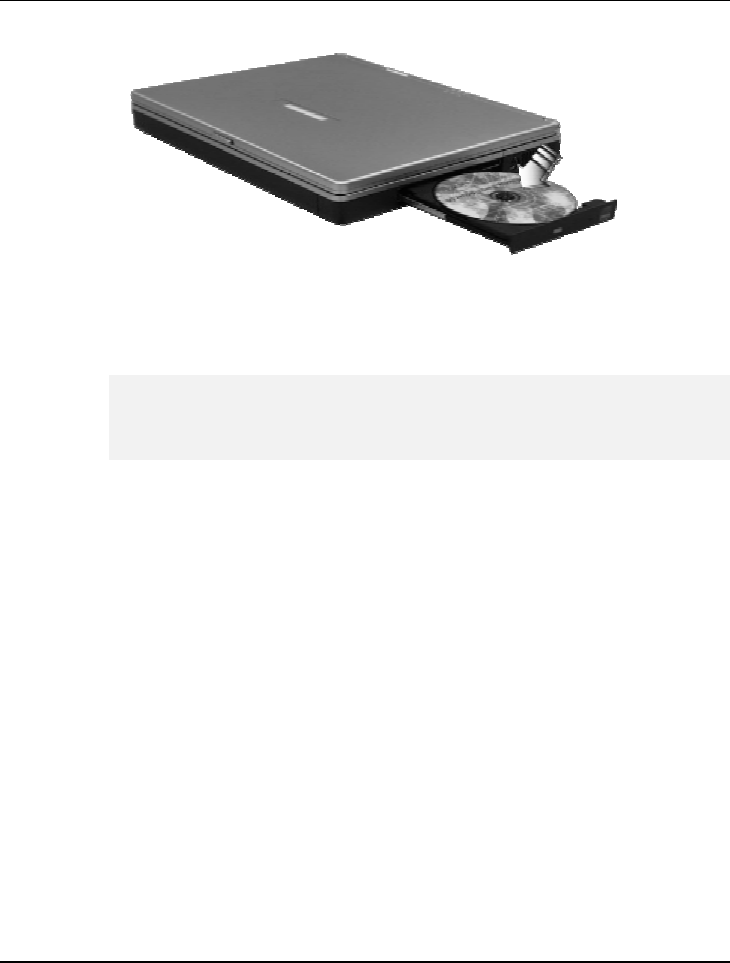
Using Your Notebook 3
65
3. To remove the disc, press on the center spindle and pull up the disc from
the side until the disc snaps out of the spindle lock.
If the eject function is disabled by software or a power failure occurs,
the Emergency Eject Hole allows you to manually remove a CD from
the reader.
4. To close the CD-ROM drive, simply push the CD tray inside. The CD-ROM
LED will activate when the disc is detected. Wait until the LED has turned
off and then start to read the disc.
The above procedures also apply to CD-RW, DVD-ROM or CD-RW/DVD
drive.
How to care the CD
When you handle CDs, pay attention to the following guidelines:
• Always pick up the CD by its edges.
• Avoid scratching or soiling either side of the CD.
• Do not write with the hard ball-point pen or apply labels on either side of
the CD.
• Keep the CD away from direct sunlight or high temperatures.
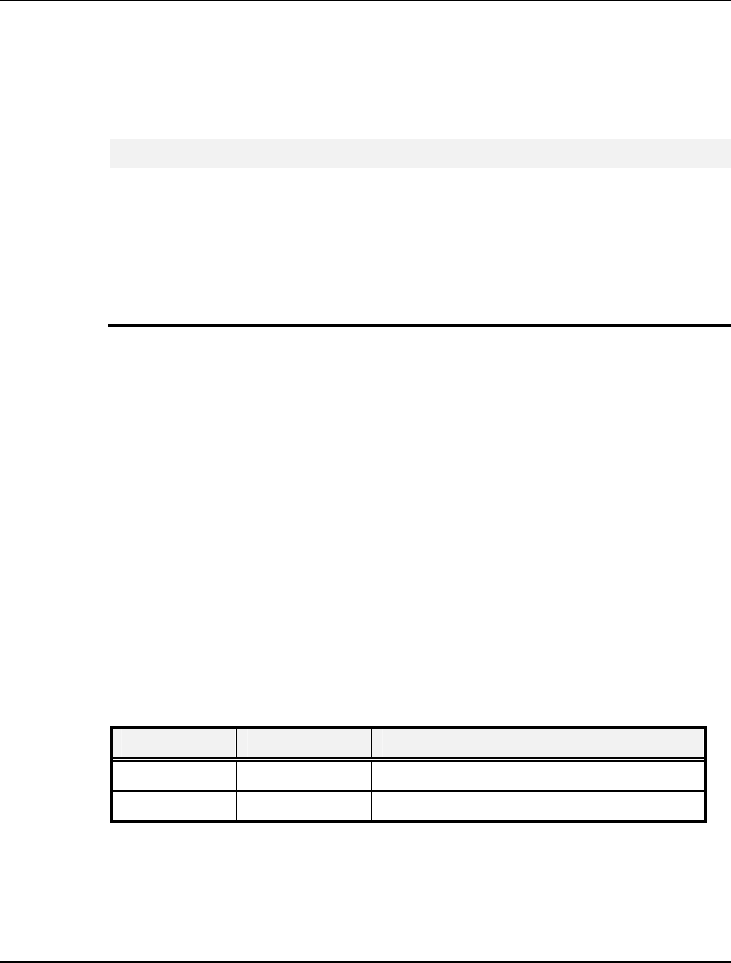
Notebook User Guide
66
• Clean fingerprints or dust from the CD by wiping it with a soft cloth.
The above points also apply to CD-RW, DVD-ROM or CD-RW/DVD drive.
The CD-ROM, DVD-ROM reader is a Class 1 Laser Product.
3.8 Using PCMCIA Cards
WHAT IS PCMCIA?
PCMCIA or Personal Computer Memory Card International Association is a
non-profit trade association that defines the industry standard for the PC Card
technology. The goal of PCMCIA is to ensure that any PC Card can work in any
mobile computer built with a PCMCIA slot.
A PC Card is a peripheral device that can add a wide variety of capabilities to your
computer including memory, mass-storage, LAN, fax/modem, wireless
communications, and multimedia. The PCMCIA standardized PC Card is
roughly the dimension of a credit card, and has a standardized 68-pin connector
at one end. The main benefits of the PC Card are its low-power consumption,
small size and ruggedness.
To allow manufacturers to add functions and technologies in the PC Card form
factor, PCMCIA has defined two PC Card types:
Type Thickness Sample Devices
Type II 5.0 mm Fax/Modem & Network Cards
Type III 10.5 mm Hard Disks (ATA Cards)

Using Your Notebook 3
67
Type II Cards
Type II card has a thickness of 5.0 millimeters (mm). Type II cards are often
storage or communications devices such as Flash Memory, LAN, and Small
Computer System Interface (SCSI). Typical Type II cards include input/output
(I/O) features such as modems and LANs. The features for Type II Cards
include following characters:
• Type II Extended Cards
Many PC cards are Type II extended cards. The extended card has an
additional physical component that protrudes beyond the traditional card
size. The extension can be as large as 40 mm deep by 9.65 mm high. This
extension provides room for additional electronics as well as a location for
external connectors. The wireless LAN card and GPRS card are examples.
The extended part is for additional electronics and antenna.
• Communication Cards
Both network PC cards and fax/modem cards can use with your notebook
computer. However, if you use built-in LAN/Modem options of this
computer, it is not necessary to use those cards. If you start the
LAN/Modem application without inserting the fax/modem card or had the
built-in LAN/Modem options installed, the application typically does not
find the card.
• Storage Cards
When you insert a storage PC card, PC card Adapter for other memory card
(i.e. Compact Flash card, Smart Media card...) or small hard drive card in the
notebook computer, it appears as a unique drive depending on the type of
card you are using.
The following table provides sample drive designations.
Sample Drive Designations

Notebook User Guide
68
Drive letter Location/Device
C: Internal hard disk
D: Internal hard disk, 2nd partition
E: CD/DVD/RW/Combo drive
F: Slot 0, high-speed memory card
Type III Cards
Type III cards are thicker (10.5 mm) than Type II cards and allow no extensions.
This notebook does not support Type III Card.
WHAT IS CARDBUS?
CardBus is the high-performance 32-bit PCI bus master interface from PCMCIA.
It runs up to 33MHz clock speed and operates at only 3.3V. Your notebook
computer incorporates the CardBus inside the PC card slot. Aside from 3.3V
CardBus PC cards, you can also insert 5V 16-bit PC cards that can also be detected
and used by your computer.
INSERTING AND REMOVING A PCMCIA CARD
Your computer includes hot swapping capability, that allows you to exchange
cards while the computer is turn on and start using it immediately.
Inserting PC Cards
To insert a PC card into the PCMCIA slot:
1. Locate the PC card slot cover on the left side of the computer.
2. Insert the side of PC card with the 68-pin socket into the PC slot. The face
label of the card should also be facing up.
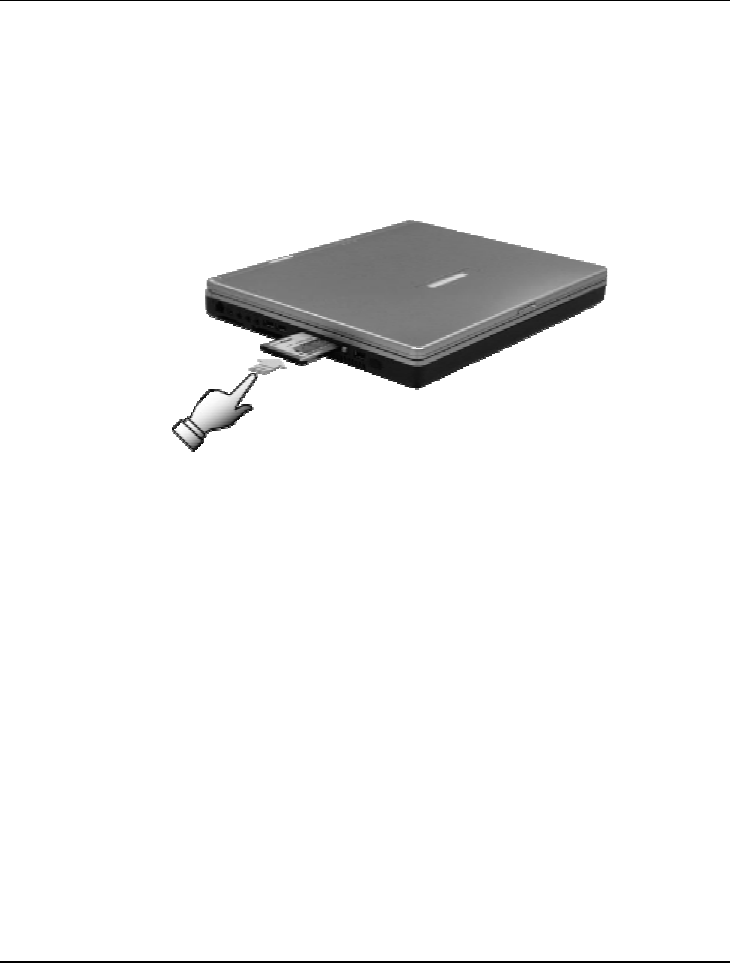
Using Your Notebook 3
69
3. When the full length of the card is almost inside the slot, push firmly but
slowly, to ensure full connection with the computer. The PC card will be
detected and once the needed driver is installed, it will generate a beep sound
to indicate that the card is detected.
Removing PC Cards
To remove a PC card from the PCMCIA slot, you should first disable the
PCMCIA card setting in the system as described followings:
1. Double click the PC card icon on the right bottom side of the task bar.
2. Select the socket from the list that you want to remove, and click Stop
button. The system then disables the function of PCMCIA card.
3. Then you can remove the inserted PC card, push the button found on the
right side of the PC slot to release the eject button. Then push it again to
release the PC card.
4. When the PC card has moved out a space out of the slot, hold the edges of
the card and slowly slide it out.

Notebook User Guide
70
MAKING PC CARDS WORK
Since PC cards come in different types and brands, making every card work on
your computer may not that be easy. PC cards like network, SCSI or
multifunction cards (MFC) need additional driver installation and configuration
in making the card work. This additional driver may already be built-in under
Windows that Windows will try to detect and prompts you if you want to install
the driver. If the driver is not included under Windows, you will need to insert
the driver CD provided by the PC card manufacturer into the CD-ROM drive and
install to Windows system. You need to read the manual guide of the PC card on
how to configure and operate the card.
Some PC cards require additional system resources. Before inserting a
PC card you may have to disable either the USB port, or the 56K internal
modem. Check the Windows device manager to ensure that there are no
conflicts of resource amount those devices.
HOT SWAPPING PC CARDS
Just like floppy disk drive, your PCMCIA slots allow you to replace one PC card
with another even while your computer is on. However, you need to remember
the rule that if the PC card is in use, you must not remove it.

Using Your Notebook 3
71
PC cards draw power even when not in use. To save energy, press the
button to disconnect the card when it is not in use.
3.9 Using Flash Memory Cards
WHAT IS FLASH MEMORY CARD?
Flash Memory is a memory storage media. It is used by most digital camera,
moreover, it can replace the traditional floppy disk. Flash memory card is built
with different form factor and brand name. Their size is smaller than PCMCIA
card. This computer supports most of the flash memory card, including MMC,
SD, Smart Media, Memory Stick and CF card.
The CF slot is used by CF (Compact Flash) card. The 4 in 1 card slot is used by
the following cards as MMC, SD, Smart Media and Memory Stick.
For a single moment, only one card can be inserted into the 4 in 1 card
slot
Inserting Flash Memory Card
To insert a flash memory card into the slot is similar to PCMCIA card. You only
need to pay more attention whenever insert the CF card or the flash memory card
into the slot with the correct side.
When you insert the CF card, the connector should be positioned at front side
toward the slot. For MMC, SD and Smart Media card, you should position the
copper connector at the bottom side. For Memory Stick card, you should
position the copper connector at the top side. All of these cards should be
located at the center of the slots in inserting.
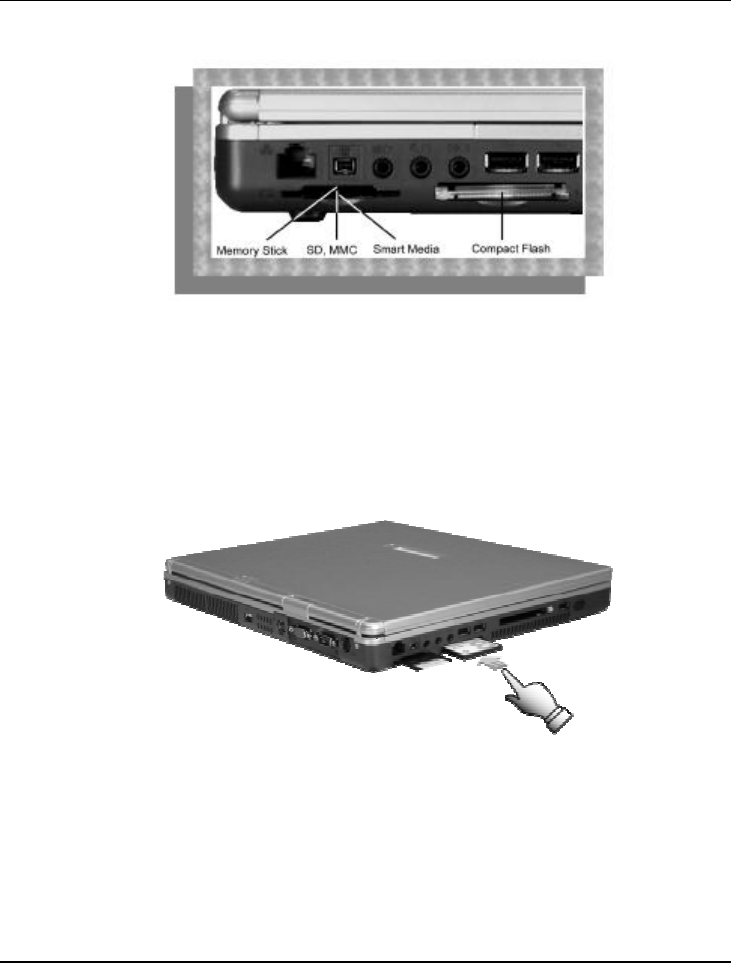
Notebook User Guide
72
Only one correct side can be accepted for the CF and 4 in 1 card slots. If you
cannot insert the card into the CF, 4 in 1 slot or you had inserted the card but it is
not recognized by the computer, please remove the card and turn the card upside
down and insert it again. To prevent the damage made both on card and the slot,
never forced an entry into the slot with incorrect side.
.
Removing Flash Memory Card
It is similar to PCMCIA card for removing a flash memory card from the slot,
you should first disable the card setting in the system as described in the
PCMCIA chapter.
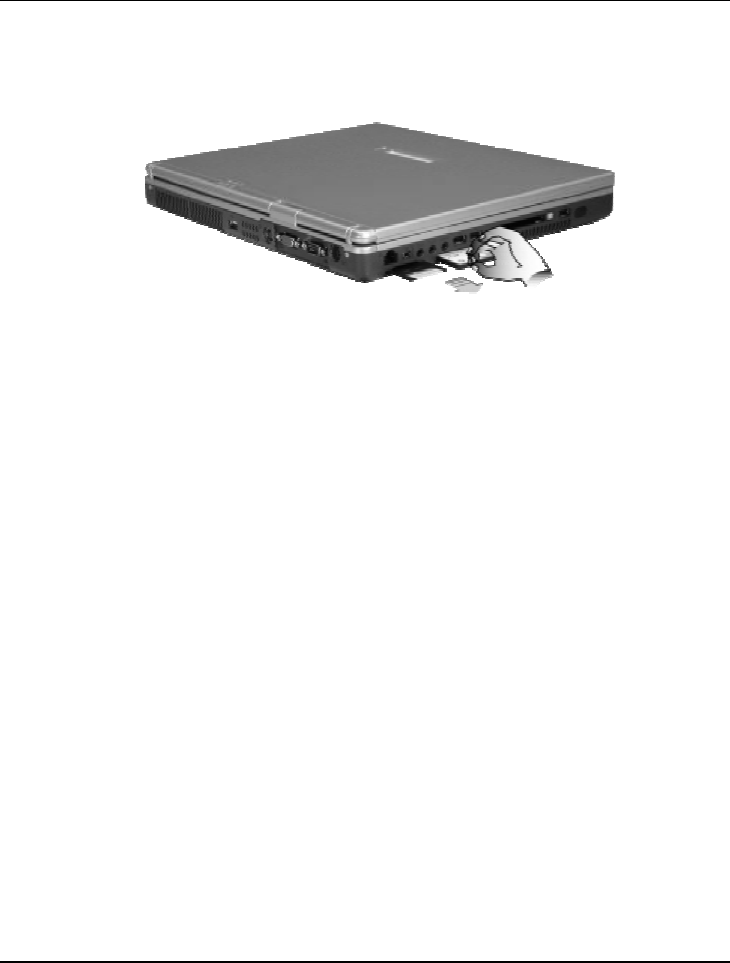
Using Your Notebook 3
73
To remove the flash memory card, you should only pull out the card by finger,
there is no release button for flash memory slot.